An Impact Analysis of Artificial Light at Night (ALAN) on Bats. A Case Study of the Historic Monument and Natura 2000 Wisłoujście Fortress in Gdansk, Poland
Abstract
1. Introduction
2. Research Background
2.1. Study Area—An Overview
2.2. Study Area—Events On-Site
Wisłoujście Festival
2.3. Pond Bat (Myotis Dasycneme)—General Information
2.4. Free-of-Charge Satellite Remote Sensing Technologies for ALAN Analysis for Non-GIS and -SRS Experts
3. Research Questions
- •
- Question 1 (Q1). Is the nature of the data presented here capable of distinguishing ALAN as the proximate cause of the population fluctuations and observed decline of the endangered pond bat (Myotis dasycneme) in the Natura 2000 area in recent years, as opposed to other influences such as noise or factors unrelated to events like the EDM festival?
- •
- Question 2 (Q2). What are the past and current light pollution levels on-site?Was there an identifiable impact from the COVID-19 lockdown on light pollution levels on-site in 2020?
- •
- Question 3 (Q3). In recent years, a new tool in the form of remote sensing has been applied to assess the scale of light pollution. Is remote sensing data also appropriate to research the Natura 2000 site, located in the Wisłoujście Fortress?
- •
- Question 4 (Q4). Are the legal conditions for the protection of the Natura 2000 Wisłoujście Fortress sufficient?
4. Materials and Methods
4.1. Data Collection for the Analysis of Land Cover in the Natura 2000 Wisłoujście Fortress
4.1.1. Source
4.1.2. Analysis Methods
4.2. Data Collection for the Analysis of Changes in the Number of Pond Bats on the Natura 2000 Wisłoujście Fortress Site
4.3. Data Collection for the Analysis of Daytime and Nighttime Events Held at the Natura 2000 Wisłoujście Fortress Site
4.4. General Overview of Changes in Light Pollution Levels
4.4.1. Source
4.4.2. Analysis Methods
4.5. Detailed Changes in Light Pollution
4.5.1. Source
- 1.
- DNB BRDF-Corrected NTL
- 2.
- Gap-Filled DNB BRDF-Corrected NTL
- 3.
- DNB Lunar Irradiance
- 4.
- Latest High-Quality Retrieval
- 5.
- Mandatory Quality Flag
- 6.
- Cloud Mask Quality Flag
- 7.
- Snow Flag
4.5.2. Analysis Methods
4.6. International, European, and Polish Regulatory Frameworks—The Most Important Approaches for Environmental Protection of Bats in the Context of Ecological Light Pollution
4.6.1. Analysis of Lighting Regulatory Frameworks (Soft Law Protection)
4.6.2. Analysis of Legal Conditions for the Protection of the Natura 2000 Wisłoujście Fortress (Hard Law Protection)
5. Results
5.1. Assessment of the Natura 2000 Wisłoujście Fortress, Together with an Assessment of Land Cover in this Area
5.2. Analysis of Changes in Light Pollution Levels and the Number of Captures of the Pond Bat during the Annual Autumn Swarming Season
5.3. Analysis of Changes in Light Pollution Levels
5.3.1. General Overview of Annual Changes in Light Pollution
5.3.2. Detailed Overview of Daily Changes in Light Pollution
5.4. Existing Regulatory Frameworks on ALAN in the Context of Environmental Protection and Bats
5.5. The Regulation of the Natura 2000 Sites in European Union Law: Birds Directive and Habitats Directive
5.6. Legal Conditions of Natura 2000 Site Protection in Poland
- 1.
- Tasks and competencies of public administration bodies responsible for Natura 2000 sites;
- 2.
- Preparation of the Natura 2000 protection management plans;
- 3.
- Supervision of Natura 2000 sites;
- 4.
- Prohibitions in Natura 2000 sites;
- 5.
- Scope of allowed activities in Natura 2000 sites;
- 6.
- Consequences of undertaking activities that may have a significant negative impact on the conservation objectives of Natura 2000 sites.
6. Discussion
7. Limitations of the Study
7.1. Research Methodology Issues
7.2. Data Issues
- •
- The main constraints are the lack of registrations on each day of the year. For instance, in the analysed area, there is a gap between week 16 and week 34 and low-quality registrations.
- •
- Remote sensing data provide a global radiance value (direct and reflected light emissions) perceived from space for a pixel, which is imprecise compared to ground-based measurements [91].
7.3. Infrastructure Issues—Collection Method
8. Conclusions
Author Contributions
Funding
Institutional Review Board Statement
Informed Consent Statement
Acknowledgments
Conflicts of Interest
Appendix A. An Overview on Bats in the Context of ALAN
Appendix A.1. Bats—An Overview
Appendix A.2. Bats and ALAN
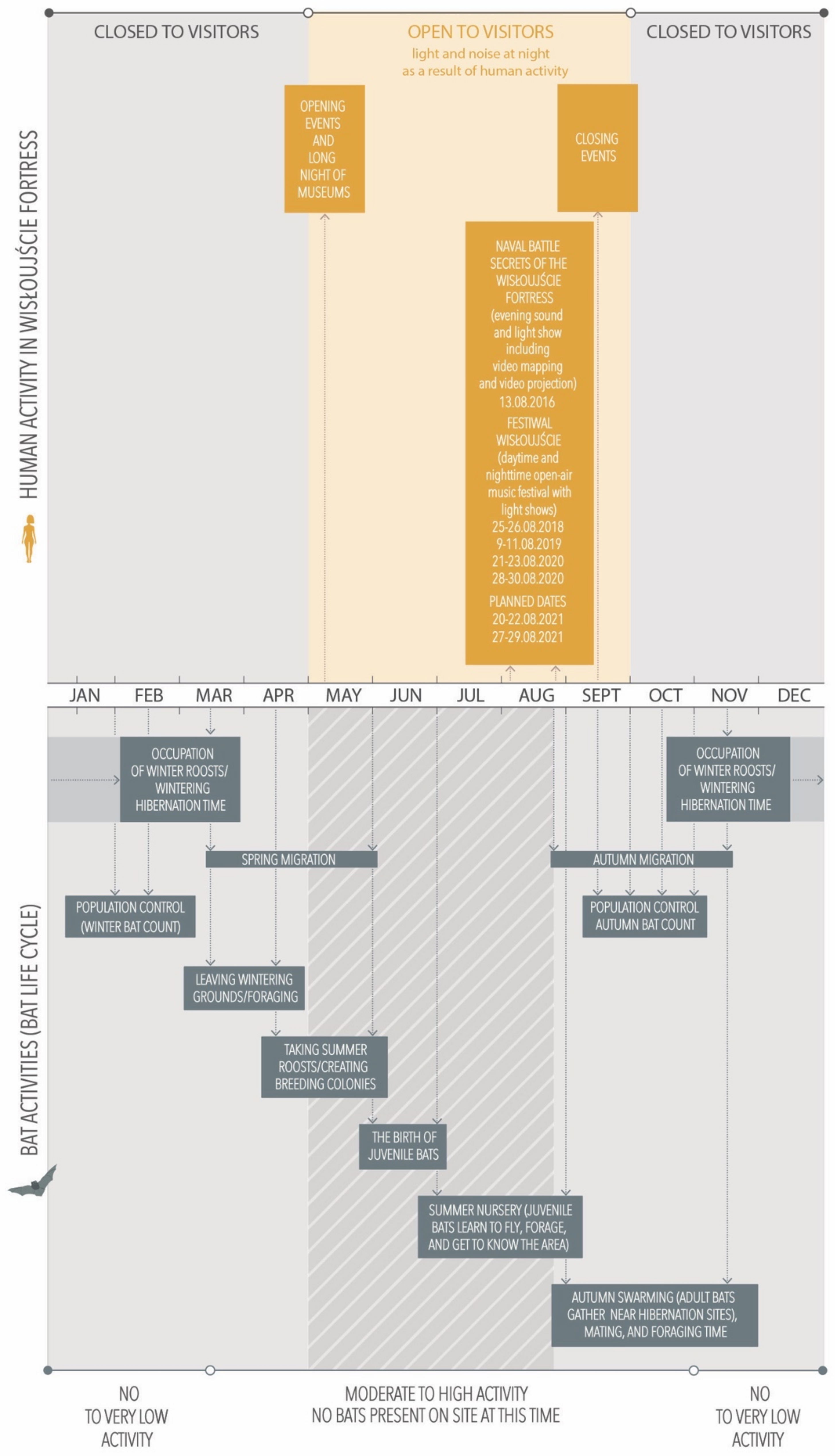
| Year | Daytime Event | Nighttime Event |
|---|---|---|
| 2011 | Naval Battle. Defence of the Wisłoujście Fortress (pl. Bitwa Morska. Obrona Twierdzy Wisłoujście) held on 16.04.2011. First edition | - |
| 2012 | Naval Battle. Defence of the Wisłoujście Fortress (pl. Bitwa Morska. Obrona Twierdzy Wisłoujście) held on 06.05.2012 | - |
| 2013 | Naval Battle. Defence of the Wisłoujście Fortress (pl. Bitwa Morska. Obrona Twierdzy Wisłoujście) held on 06.07.2013 | - |
| 2014 | Naval Battle. Defence of the Wisłoujście Fortress (pl. Bitwa Morska. Obrona Twierdzy Wisłoujście) held on 26.07.2014 | - |
| Naval Battle on the Motlau River during the Baltic Sail event. Event moved to a different location held on the river on 6.07. 2014 | ||
| 2015 | Naval Battle on the Motlau River during the Baltic Sail event. Event moved to a different location on the river, held on 4.07. 2015 at 20:15–21:00 | - |
| 2016 | Naval Battle on the Motlau River during the Baltic Sail Gdańsk event. Event held in a different location on the river on 3.07.2016 | Evening sound and light show: Naval Battle. Secrets of the Wisłoujście Fortress (pl. Bitwa Morska. Tajemnice Twierdzy Wisłoujście) held on 13.08.2016 at 9:30 p.m. [152,153] |
| 2017 | Closing event held on 30.09.2017 with the firing of artillery of cannons | Naval Battle on the Motlau River during the XXI Baltic Sail Gdańsk event. Event moved to a different location on the river on 1.07.2017 [154] |
| 2018 | Naval Battle. Defence of the Wisłoujście Fortress (pl. Bitwa Morska. Obrona Twierdzy Wisłoujście) held on 07.07.2018 | Daytime and nighttime annual EDM Festiwal Wisłoujście, 1st edition held on 25–26.08.2018 [155] |
| Closing event. (pl. Pożegnanie lata w Twierdzy Wisłoujście) held on 30.09.2018 | ||
| 2019 | Naval and Land Battle Wisłoujście 1577. Wisłoujście Fortress (pl. Bitwa Morska i Lądowa Wisłoujście 1577) held on 06.07.2019 | Daytime and nighttime annual EDM Festiwal Wisłoujście, 2nd edition held on 9–10.08.2019 [156] |
| 2020 | The COVID-19 lockdown caused the cancellation of most events | Daytime and nighttime annual EDM Festiwal Wisłoujście, 3rd edition held on 21–23.08.2020 and 28–30.08.2020 [157] |
Appendix B. Regulatory Frameworks for ALAN and Bats
| Category | Year | Name | Country of Origin |
|---|---|---|---|
| Guidelines | 2001 | Bats in Forests—Information and recommendations for forest managers by the Federal Agency for Nature Conservation (Bundesamt für Naturschutz—BfN) and the German Association for Landcare (Deutscher Verband für Landschaftspflege—DVL) [158] | Germany/EU |
| 2006 | Bats In Houses—Guidance for Householders by the Irish National Parks and Wildlife Service (NPWS) in cooperation with Bat Conservation Ireland [159] | Ireland | |
| 2006 | Bat Roost in the Alpine Area: Guidelines for Renovation of Buildings by the Centre for Bat Conservation and Research in Austria (KFFÖ) [160] | Austria | |
| 2009 | Artificial Light in the Environment Report by the Royal Commission on Environmental Pollution [161] | UK | |
| 2011 | Building Bat Friendly: information for home owners, architects and policy officers by Landschapsbeheer Flevoland, the Dutch Mammal Society and TAUW [162] | NL/EU | |
| 2012 | Landscape and urban design for bats and biodiversity by Bat Conservation Trust [163] | UK | |
| 2013 | PLG04 Guidance on undertaking environmental lighting impact assessments by the Institution of Lighting Professionals (ILP) [164] | UK | |
| 2014 | Nature-friendlier lighting of objects of cultural heritage (churches) by Dark-Sky Slovenia [165] | Slovenia | |
| 2016 | CIBSE LG06/16. Lighting Guide 6: the exterior environment by the Chartered Institution of Building Services Engineers (CIBSE) and Society of Light and Lighting (SLL) [166] | UK | |
| 2017 | CIE 150:2017. Guide on the Limitation of the Effects of Obtrusive Light from Outdoor Installations, 2nd Edition by the International Commission on Illumination (CIE) [167] | International | |
| 2017 | EUROBATS guidelines no. 5. Guidelines for Surveillance and Monitoring of European Bats, 3rd edition by the United Nations Environment [168] | EU/International | |
| 2017 | EUROBATS guidelines no. 4. Protection of overground roosts for bats by the United Nations Environment [169] | EU/International | |
| 2018 | GN08/18. Guidance Note 8 for Bats and Artificial Lighting by the Institution of Lighting Professionals (ILP) [170] | UK | |
| 2018 | EUROBATS guidelines no. 8. Guidelines for consideration of bats in lighting projects by the United Nations Environment [53] | EU/International | |
| 2018 | WaterSpace Design Guidance. Protecting Bats in Waterside Development by the Planning Department of Bath and North East Somerset Council [171] | UK | |
| 2019 | Designing for Biodiversity. A Technical Guide for New and Existing Buildings by Bat Conservation Trust and RIBA Publishing [172] | UK | |
| 2019 | EUROBATS guidelines no. 9. Guidance on the conservation and management of critical feeding areas and commuting routes for bats by the United Nations Environment Programme [173] | EU/International | |
| 2020 | GN01/20. Guidance Note 1 for the reduction of obtrusive light 2020 by the Institution of Lighting Professionals (ILP) [174] | UK | |
| Procedures | 2000 | Action Plan for the Conservation of the Pond Bat in Europe: Myotis Dasycneme (Nature and Environment) by the Council of Europe [175] | International |
| 2004 | Bat Workers’ Manual by the Joint Nature Conservation Committee JNCC [176] | UK | |
| 2010 | EUROBATS guidelines no. 2. Protecting and managing underground sites for bats by the United Nations Environment Programme [177] | EU/International | |
| 2011 | Model Lighting Ordinance (MLO)—User’s Guide by the International Dark-Sky Association (IDA) and Illuminating Engineering Society of North America (IESNA) [178] | USA/International | |
| 2015/2019 | A guide to the implementation of the Agreement on the Conservation of Populations of European Bats (EUROBATS) [179] | EU | |
| 2018 | Action Plan for the Conservation of All Bat Species in the European Union 2018–2024 by European Commission [180] | EU | |
| Standards and Codes | 2012 | The SLL Code for Lighting by The Society of Light and Lighting (SLL) [181] | UK |
| 2003/2015 | EN 13201-2: Road lighting—Part 2: Performance requirements by the European Committee for Standardisation (CEN) [182] | EU | |
| 2014 | EN 12464-2 Light and Lighting—Lighting of Work Places, Part 2: Outdoor Work Places by the European Committee for Standardisation (CEN) [183] | EU | |
| 2020 | ANSI/IES LP-11-20 Environmental Considerations for Outdoor Lighting by the American National Standards Institute and Illuminating Engineering Society [184] | USA/International |
Appendix C. A Short Overview of the DMSP-OLS and Suomi NPP-VIIRS Satellites/Sensors
Appendix C.1. The Operational Linescan System Sensor
Appendix C.2. The Visible Infrared Imaging Radiometer Suite Sensor
| Category | DMSP | Suomi |
|---|---|---|
| Sensor | OLS | VIIRS-DNB |
| Accessibility | Free of charge | Free of charge |
| Availability of data in years | 1992–2013 | 2012.04–2021.03 |
| Data coverage | Annually | Annually, monthly, daily |
| Spectral bands | 400–1100 nm | 505–890 nm |
| Image resolution | 30 arcsecond/~1 km at the Equator | 15 arcsecond/~500 m at the Equator (VNP46) |
| Radiometric resolution | 6 bit | 14 bit |
| Swath width | 2964 km | 3040 km |
| Available at | https://www.ngdc.noaa.gov/eog/download.html (accessed on 5 May 2021) | https://www.ngdc.noaa.gov/eog/download.html (accessed on 5 May 2021) https://ladsweb.modaps.eosdis.nasa.gov/archive/allData/5000/VNP46A2/ (accessed on 5 May 2021) |
Appendix C.3. Interactive Web Mapping Services to Visually Show Light Pollution Levels
| Category | Light Pollution Map (LPM) | Radiance Light Trends (RLT) |
|---|---|---|
| VIIRS overlays * | Average combined | Median combined |
| Outlier ** | No outlier removal | Outlier removal |
| Calibration | Zero-point calibration | With or without zero-point calibration |
Appendix D. The Natura 2000 Wisłoujście Fortress Site PLH220030 and Its Protection Management Plan
- 1.
- The Habitats Directive: Annex I (as an animal species of Community interest whose conservation requires the designation of special SAC) and Annex IV (as an animal species of Community interest in need of strict protection);
- 2.
- The Bern Convention on the Conservation of European Wildlife and Natural Habitats: Annex II (Strictly protected fauna species);
- 3.
- The Convention on the Conservation of Migratory Species of Wild Animals: Annex II (as migratory species requiring international cooperation);
- 4.
- The Agreement on the Conservation of Populations of European Bats (EUROBATS) (as an animal species occurring in Europe);
- 5.
- Ordinance of the Minister of Environment on the protection of animal species: Annex IV (as an animal species requiring the establishment of zones for the protection of sanctuaries, breeding sites, or regular places of residence and their size);
- 6.
- The pond bat species (Myotis dasycneme) is also on the International Union for Conservation of Nature (IUCN) Red List of Threatened Species, classified as “near-threatened” (NT) [46]. This means the species is close to being at high risk of extinction in the near future.
References
- Longcore, T.; Rich, C. Ecological light pollution. Front. Ecol. Environ. 2004, 2, 191–198. [Google Scholar] [CrossRef]
- Sanders, D.; Frago, E.; Kehoe, R.; Patterson, C.; Gaston, K.J. A meta-analysis of biological impacts of artificial light at night. Nat. Ecol. Evol. 2021, 5, 74–81. [Google Scholar] [CrossRef] [PubMed]
- Gaynor, K.M.; Hojnowski, C.E.; Carter, N.H.; Brashares, J.S. The influence of human disturbance on wildlife nocturnality. Science 2018, 360, 1232–1235. [Google Scholar] [CrossRef] [PubMed]
- Schirmer, A.E.; Gallemore, C.; Liu, T.; Magle, S.; Dinello, E.; Ahmed, H.; Gilday, T. Mapping behaviorally relevant light pollution levels to improve urban habitat planning. Sci. Rep. 2019, 9, 1–13. [Google Scholar] [CrossRef]
- Bará, S.; Lima, R.C. Photons without borders: Quantifying light pollution transfer between territories. Int. J. Sustain. Light. 2018, 20, 51–61. [Google Scholar] [CrossRef]
- Jechow, A.; Kyba, C.C.; Hölker, F. Beyond All-Sky: Assessing Ecological Light Pollution Using Multi-Spectral Full-Sphere Fisheye Lens Imaging. J. Imaging 2019, 5, 46. [Google Scholar] [CrossRef] [PubMed]
- Schroer, S.; Huggins, B.J.; Azam, C.; Hölker, F. Working with Inadequate Tools: Legislative Shortcomings in Protection against Ecological Effects of Artificial Light at Night. Sustainability 2020, 12, 2551. [Google Scholar] [CrossRef]
- Morgan-Taylor, M. Regulating Light Pollution in Europe: Legal Challenges and Ways Forward. In Urban Lighting, Light Pollution, and Society; Routledge: London, UK, 2015. [Google Scholar]
- Bará, S. Anthropogenic disruption of the night sky darkness in urban and rural areas. R. Soc. Open Sci. 2016, 3, 160541. [Google Scholar] [CrossRef]
- Szaz, D.; Horvath, G.; Barta, A.; Robertson, B.A.; Farkas, A.; Egri, A.; Tarjanyi, N.; Racz, G.; Kriska, G. Lamp-Lit Bridges as Dual Light-Traps for the Night-Swarming Mayfly, Ephoron virgo: Interaction of Polarized and Unpolarized Light Pollution. PLoS ONE 2015, 10, e0121194. [Google Scholar] [CrossRef]
- Cho, Y.; Ryu, S.-H.; Lee, B.R.; Kim, K.H.; Lee, E.; Choi, J. Effects of artificial light at night on human health: A literature review of observational and experimental studies applied to exposure assessment. Chronobiol. Int. 2015, 32, 1294–1310. [Google Scholar] [CrossRef] [PubMed]
- Bolliger, J.; Hennet, T.; Wermelinger, B.; Bösch, R.; Pazur, R.; Blum, S.; Haller, J.; Obrist, M.K. Effects of traffic-regulated street lighting on nocturnal insect abundance and bat activity. Basic Appl. Ecol. 2020, 47, 44–56. [Google Scholar] [CrossRef]
- Supronowicz, R.; Fryc, I. Urban park lighting as a source of botanical light pollution. Photon-Lett. Pol. 2019, 11, 90–92. [Google Scholar] [CrossRef]
- Bobkowska, K.; Janowski, A.; Jasinska, K.; Kowal, P.; Przyborski, M. Light pollution in the context of threats to the wildlife corridors. In Proceedings of the 16th International Multidisciplinary Scientific GeoConference SGEM2016, Vienna, Austria, 2–5 November 2016; STEF92 Technology: Sofia, Bulgaria, 2016; pp. 665–670. [Google Scholar]
- Miner, K.A.; Huertas, M.; Aspbury, A.S.; Gabor, C.R. Artificial Light at Night Alters the Physiology and Behavior of Western Mosquitofish (Gambusia affinis). Front. Ecol. Evol. 2021, 9, 617063. [Google Scholar] [CrossRef]
- Garrett, J.K.; Donald, P.F.; Gaston, K.J. Skyglow extends into the world’s Key Biodiversity Areas. Anim. Conserv. 2019, 23, 153–159. [Google Scholar] [CrossRef]
- Owens, A.C.S.; Cochard, P.; Durrant, J.; Farnworth, B.; Perkin, E.K.; Seymoure, B. Light Pollution is a Driver of Insect Declines. Biol. Conserv. 2020, 241, 108259. [Google Scholar] [CrossRef]
- Falcón, J.; Torriglia, A.; Attia, D.; Viénot, F.; Gronfier, C.; Behar-Cohen, F.; Martinsons, C.; Hicks, D. Exposure to Artificial Light at Night and the Consequences for Flora, Fauna, and Ecosystems. Front. Neurosci. 2020, 14, 1183. [Google Scholar] [CrossRef]
- Grubisic, M.; Haim, A.; Bhusal, P.; Dominoni, D.M.; Gabriel, K.M.A.; Jechow, A.; Kupprat, F.; Lerner, A.; Marchant, P.; Riley, W.; et al. Light Pollution, Circadian Photoreception, and Melatonin in Vertebrates. Sustainability 2019, 11, 6400. [Google Scholar] [CrossRef]
- Zielinska-Dabkowska, K.M. Make lighting healthier. Nature 2018, 553, 274–276. [Google Scholar] [CrossRef] [PubMed]
- Rybnikova, N.; Portnov, B.A. Population-level study links short-wavelength nighttime illumination with breast cancer inci-dence in a major metropolitan area. Chronobiol. Int. 2018, 35, 1198–1208. [Google Scholar] [CrossRef] [PubMed]
- Jägerbrand, A. Development of an Indicator System for Local Governments to Plan and Evaluate Sustainable Outdoor Lighting. Sustainability 2021, 13, 1506. [Google Scholar] [CrossRef]
- Wainscoat, R.J. The magnificent night sky—Why it must be protected from light pollution. Proc. Int. Astron. Union 2009, 5, 442–448. [Google Scholar] [CrossRef]
- Wesołowski, M. Impact of light pollution on the visibility of astronomical objects in medium-sized cities in Central Europe on the example of the city of Rzeszów, Poland. J. Astrophys. Astron. 2019, 40, 20. [Google Scholar] [CrossRef]
- Papalambrou, A.; Doulos, L.T. Identifying, Examining, and Planning Areas Protected from Light Pollution. The Case Study of Planning the First National Dark Sky Park in Greece. Sustainability 2019, 11, 5963. [Google Scholar] [CrossRef]
- Henderson, D. Valuing the Stars: On the Economics of Light Pollution. Environ. Philos. 2010, 7, 17–26. [Google Scholar] [CrossRef]
- Zielinska-Dabkowska, K.M.; Xavia, K.; Bobkowska, K. Assessment of Citizens’ Actions against Light Pollution with Guide-lines for Future Initiatives. Sustainability 2020, 12, 4997. [Google Scholar] [CrossRef]
- Shirley, M.D.F.; Armitage, V.L.; Barden, T.L.; Gough, M.; Lurz, P.W.W.; Oatway, D.E.; South, A.B.; Rushton, S.P. Assessing the impact of a music festival on the emergence behaviour of a breeding colony of Dauben-ton’s bats (Myotis daubentonii). J. Zool. 2011, 254, 367–373. [Google Scholar] [CrossRef]
- Twierdza Wisłoujście. Available online: http://www.ine.eko.org.pl/index_areas.php?rek=197 (accessed on 5 May 2021).
- WISŁOUJŚCIE. Available online: https://wisloujscie.com/# (accessed on 5 May 2021).
- Van Schaik, J.; Janssen, R.; Bosch, T.; Haarsma, A.J.; Dekker, J.J.; Kranstauber, B. Bats Swarm Where They Hibernate: Compositional Similarity between Autumn Swarming and Winter Hibernation Assemblages at Five Underground Sites. PLoS ONE 2015, 10, e0130850. [Google Scholar] [CrossRef] [PubMed]
- Myotis Dasycneme. Available online: https://www.eurobats.org/about_eurobats/protected_bat_species/myotis_dasycneme (accessed on 5 May 2021).
- Nocek Łydkowłosy. Available online: http://siedliska.gios.gov.pl/images/pliki_pdf/publikacje/pojedyncze_metodyki_dla_gat_zwierzat/Nocek-ydkowosy-Myotis-dasycneme.pdf (accessed on 5 May 2021).
- MHMG—Twierdza Wisłoujście Otwarcie Sezonu 2017. Available online: https://youtu.be/-MDaPGI8CCg (accessed on 5 May 2021).
- Myotis Dasycneme. Available online: https://batslife.eu/item/myotis-dasycneme/ (accessed on 5 May 2021).
- NATURA 2000—Standard Data Form. Available online: https://natura2000.eea.europa.eu/Natura2000/SDF.aspx?site=PLH220030 (accessed on 5 May 2021).
- Natura 2000. Available online: https://ec.europa.eu/environment/nature/natura2000/index_en.htm#:~:text=Natura%202000%20is%20a%20network,on%20land%20and%20at%20sea (accessed on 5 May 2021).
- Gdańsk—The Wisłoujście Fortress. Available online: https://zabytek.pl/en/obiekty/gdansk-gdansk-twierdza-wisloujscie?langset=true (accessed on 5 May 2021).
- Journal of Laws of the Republic of Poland. Warsaw, 25 May of 2018, Item 1008. Regulation of the President of the Republic of Poland of 20 April 2018 on the Recognition of Gdańsk Wisłoujście Fortress as a Historical Monument. Available online: https://zabytek.pl/public/upload/objects_media/5b0e4fc700fb5.pdf (accessed on 5 May 2021).
- Bitwa Morska na Martwej Wiśle. Najlepiej Oglądać z Nowego Portu. Available online: https://rozrywka.trojmiasto.pl/Bitwa-Morska-w-nowej-multimedialnej-odslonie-n104523.html (accessed on 5 May 2021).
- WISŁOUJŚCIE 2018—AFTERMOVIE RAJ. Available online: https://www.youtube.com/watch?v=IPrd14lzoyk (accessed on 5 May 2021).
- BESKRES dj set by KAMP!@WISŁOUJŚCIE 2019. Available online: https://www.youtube.com/watch?v=pPEq5HlqX5g (accessed on 5 May 2021).
- Twierdza Wisłoujście. 2020. Available online: https://www.youtube.com/watch?v=Ok1uEGhw2xc (accessed on 5 May 2021).
- DUSS—Wisłoujście 2019—Gdańsk. Available online: https://www.youtube.com/watch?v=UWSLiD6SktY (accessed on 5 May 2021).
- Furey, N.M.; Racey, P.A. Conservation Ecology of Cave Bats. In Bats in the Anthropocene: Conservation of Bats in a Changing World; Voigt, C., Kingston, T., Eds.; Springer: Cham, UK, 2016; pp. 463–500. [Google Scholar]
- Myotis Dasycneme. Available online: https://www.iucnredlist.org/species/14127/22055164 (accessed on 5 May 2021).
- Bunkley, J.P.; McClure, C.J.W.; Kleist, N.J.; Francis, C.D.; Barber, J.R. Anthropogenic noise alters bat activity levels and ech-olocation calls. Glob. Ecol. Conserv. 2015, 3, 62–71. [Google Scholar] [CrossRef]
- Luo, J.; Siemers, B.M.; Koselj, K. How anthropogenic noise affects foraging. Glob. Chang. Biol. 2015, 21, 3278–3289. [Google Scholar] [CrossRef]
- Racey, P.A.; Hutson, A.M.; Lina, P.H.C. Bat Rabies, Public Health and European Bat Conservation. Zoonoses Public Health 2012, 60, 58–68. [Google Scholar] [CrossRef]
- Ciechanowski, M.; Sachanowicz, K.; Kokurewicz, T. Rare or underestimated? The distribution and abundance of the pond bat (Myotis dasycneme) in Poland. Lutra 2007, 50, 107–134. [Google Scholar]
- Rozporządzenie Ministra Środowiska z dnia 6 Października 2014 r. w Sprawie Ochrony Gatunkowej Zwierząt (Dz.U. z 2014 r. poz. 1348). Available online: http://isap.sejm.gov.pl/isap.nsf/DocDetails.xsp?id=WDU20140001348 (accessed on 5 May 2021).
- Rozporządzenie Ministra Środowiska z dnia 16 Grudnia 2016 r. w Sprawie Ochrony Gatunkowej Zwierząt (Dz. U. z 2016 r., poz. 2183). Available online: https://sip.lex.pl/akty-prawne/dzu-dziennik-ustaw/ochrona-gatunkowa-zwierzat-18553186UWSLiD6SktY (accessed on 23 October 2021).
- The United Nations Environment Programme (UNEP). EUROBATS Guidelines No. 8. Guidelines for Consideration of Bats in Lighting Projects. Available online: https://www.eurobats.org/node/1563 (accessed on 5 May 2021).
- Erkert, H.G. Ecological Aspects of Bat Activity Rhythms. In Ecology of Bats; Kunz, T.H., Ed.; Boston University Press: Boston, MA, USA, 1982; pp. 201–242. [Google Scholar]
- Rydell, J.; Entwistle, A.; Racey, P.A. Timing of foraging flights of three species of bats in relation to insect activity and preda-tion risk. Oikos 1996, 76, 243–252. [Google Scholar] [CrossRef]
- Levin, N.; Kyba, C.C.; Zhang, Q.; de Miguel, A.S.; Román, M.O.; Li, X.; Portnov, B.A.; Molthan, A.L.; Jechow, A.; Miller, S.D.; et al. Remote sensing of night lights: A review and an outlook for the future. Remote Sens. Environ. 2019, 237, 111443. [Google Scholar] [CrossRef]
- Zhao, M.; Zhou, Y.; Li, X.; Cao, W.; He, C.; Yu, B.; Elvidge, C.D.; Cheng, W. Applications of Satellite Remote Sensing of Nighttime Light Observations: Advances, Challenges, and Perspectives. Remote Sens. 2019, 11, 1971. [Google Scholar] [CrossRef]
- Informacje. Available online: https://www.geoportal.gov.pl/o-geoportalu/informacje (accessed on 5 May 2021).
- Portal BDOT10k. Available online: https://www.geoportal.gov.pl/portal-bdot10k (accessed on 5 May 2021).
- Salkind, N.J. Encyclopedia of Research Design (Vols. 1-0); SAGE Publications, Inc.: Thousand Oaks, CA, USA, 2010. [Google Scholar]
- Coesfeld, J.; Kuester, T.; Kuechly, H.U.; Kyba, C.C.M. Reducing Variability and Removing Natural Light from Nighttime Satellite Imagery: A Case Study Using the VIIRS DNB. Sensors 2020, 20, 3287. [Google Scholar] [CrossRef] [PubMed]
- Román, M.O.; Wang, Z.; Sun, Q.; Kalb, V.; Miller, S.D.; Molthan, A.; Schultz, L.; Bell, J.; Stokes, E.C.; Pandey, B.; et al. NASA’s Black Marble nighttime lights product suite. Remote Sens. Environ. 2018, 210, 113–143. [Google Scholar] [CrossRef]
- Smits, J.M. What Is Legal Doctrine? On the Aims and Methods of Legal-Dogmatic Research. In Rethinking Legal Scholarship: A Transatlantic Dialogue; Van Gestel, R., Micklitz, H.W., Rubin, E.L., Eds.; Cambridge University Press: Cambridge, UK, 2017; pp. 207–228. [Google Scholar]
- Ciechanowski, M.; Jankowska-Jarek, M.; Bidziński, K. Report on the Monitoring of Hibernating Bats (with Special Consideration of Myotis Dasycneme) in the Natura 2000 Site Twierdza Wisłoujście PLH 220030 in 2021, Commissioned by the Regional Directorate for Environmental Protection in Gdańsk. Available online: https://www.szybkiplik.pl/XK99U8tTY7 (accessed on 23 October 2021).
- Gdańsk: Wymiana Oświetlenia ulic Pochłonie 5 mln zł. Available online: https://www.prawo.pl/samorzad/gdansk-wymiana-oswietlenia-ulic-pochlonie-5-mln-zl,230259.html (accessed on 5 May 2021).
- 4400 nowych lamp LED na 69 ulicach i wszystko jasne. Available online: https://www.gdansk.pl/wiadomosci/4400-nowych-lamp-led-na-69-ulicach-i-wszystko-jasne-zobacz-gdzie,a,82609 (accessed on 5 May 2021).
- Natura 2000. Available online: https://ec.europa.eu/environment/nature/natura2000/index_en.htm (accessed on 5 May 2021).
- European Commission. Environment Directorate General. The EU Birds and Habitats Directives. For Nature and People in Europe. 2015. Available online: https://op.europa.eu/en/publication-detail/-/publication/7230759d-f136-44ae-9715-1eacc26a11af (accessed on 26 March 2021).
- Directive 2009/147/EC of the European Parliament and of the Council. Official Journal of the European Union L 20/7 as Amended. 26 January 2010. Available online: https://eur-lex.europa.eu/legal-content/EN/TXT/?uri=CELEX%3A32009L0147 (accessed on 26 March 2021).
- Council Directive 92/43/EEC of 21 May 1992 on the Conservation of Natural Habitats and of Wild Fauna and Flora. Official Journal of the European Union L 206. 22 July 1992. Available online: https://eur-lex.europa.eu/legal-content/EN/TXT/?uri=celex%3A31992L0043 (accessed on 26 March 2021).
- European Commission. Consolidated Version of the Treaty on the Functioning of the European Union. 2012. Available online: https://eur-lex.europa.eu/legal-content/EN/TXT/?uri=celex%3A12012E%2FTXT (accessed on 26 August 2020).
- European Commission Communication. The European Green Deal. Brussels. 19 December 2019. Available online: https://eur-lex.europa.eu/legal-content/EN/TXT/?qid=1596443911913&uri=CELEX:52019DC0640#document2 (accessed on 26 August 2020).
- European Commission (EC). The European Biodiversity Strategy 2030: Bringing Nature Back into Our Lives; European Commission: Brussels, Belgium, 2020; Available online: https://eur-lex.europa.eu/legal-content/EN/TXT/?qid=1590574123338&uri=CELEX:52020DC0380 (accessed on 26 August 2020).
- Law on Protection against Light Pollution of 25 January 2019. Official Journal of the Republic of Croatia, 7.02.2019, No. 14/19, Item 271. Available online: https://www.ecolex.org/details/legislation/law-on-protection-from-light-pollution-lex-faoc106044/ (accessed on 23 October 2021).
- Act of 24 July 2019 Amending the Bavarian Nature Conservation Act. Bavarian Official Journal of 31.07.2019, No. 2019/14, Item 791-1-U.. Available online: https://www.fao.org/faolex/results/details/en/c/LEX-FAOC108077/ (accessed on 23 October 2021).
- Journal of Laws of the French Republic of 28 December 2018, No. 17, Item 197. Available online: https://www.legifrance.gouv.fr/loda/id/JORFTEXT000037864346/ (accessed on 23 October 2021).
- Act of 16 April 2004 on the Conservation of Nature. Uniform text Journal of Laws of 2020, Item 55 as Amended. Available online: https://www.global-regulation.com/translation/poland/3353949/the-act-of-16-april-2004-on-the-protection-of-nature.html (accessed on 23 October 2021).
- De Miguel, A.S.; Bennie, J.; Rosenfeld, E.; Dzurjak, S.; Gaston, K.J. First Estimation of Global Trends in Nocturnal Power Emissions Reveals Acceleration of Light Pollution. Remote Sens. 2021, 13, 3311. [Google Scholar] [CrossRef]
- Falchi, F.; Cinzano, P.; Duriscoe, D.; Kyba, C.C.M.; Elvidge, C.D.; Baugh, K.; Portnov, B.A.; Rybnikova, N.A.; Furgoni, R. The new world atlas of artificial night sky brightness. Sci. Adv. 2016, 2, e1600377. [Google Scholar] [CrossRef] [PubMed]
- Sky Quality Meter. Available online: http://unihedron.com/projects/darksky/magconv.php?ACTION=SOLVE&txtMAGSQA=18.52 (accessed on 16 August 2021).
- Jechow, A.; Kyba, C.C.; Hölker, F. Mapping the brightness and color of urban to rural skyglow with all-sky photometry. J. Quant. Spectrosc. Radiat. Transf. 2020, 250, 106988. [Google Scholar] [CrossRef]
- Sutton, P.C. An Empirical Environmental Sustainability Index Derived Solely from Nighttime Satellite Imagery and Eco-system Service Valuation. Popul. Environ. 2003, 24, 293–311. [Google Scholar] [CrossRef]
- Levin, N.; Duke, Y. High spatial resolution night-time light images for demographic and socio-economic studies. Remote Sens. Environ. 2012, 119, 1–10. [Google Scholar] [CrossRef]
- Bennie, J.; Duffy, J.P.; Davies, T.W.; Correa-Cano, M.E.; Gaston, K.J. Global Trends in Exposure to Light Pollution in Natural Terrestrial Ecosystems. Remote Sens. 2015, 7, 2715–2730. [Google Scholar] [CrossRef]
- Mu, H.; Li, X.; Du, X.; Huang, J.; Su, W.; Hu, T.; Wen, Y.; Yin, P.; Han, Y.; Xue, F. Evaluation of Light Pollution in Global Pro-tected Areas from 1992 to 2018. Remote Sens. 2021, 13, 1849. [Google Scholar] [CrossRef]
- Chalkias, C.; Petrakis, M.; Psiloglou, B.; Lianou, M. Modelling of light pollution in suburban areas using remotely sensed imagery and GIS. J. Environ. Manag. 2006, 79, 57–63. [Google Scholar] [CrossRef] [PubMed]
- Bustamante-Calabria, M.; Sánchez de Miguel, A.; Martín-Ruiz, S.; Ortiz, J.-L.; Vílchez, J.M.; Pelegrina, A.; García, A.; Zamo-rano, J.; Bennie, J.; Gaston, K.J. Effects of the COVID-19 Lockdown on Urban Light Emissions: Ground and Satellite Com-parison. Remote Sens. 2021, 13, 258. [Google Scholar] [CrossRef]
- García-Saenz, A.; Sanchez-de-Miguel, A.; Espinosa, A.; Valentín, L.; Costas, L.; Castaño-Vinyals, G.; Moreno, M.; Pollán, M.; Aubé, M.; Kogevinas, M. Artificial light at night (ALAN), blue light spectrum exposure and colorectal cancer risk in Spain (MCC-Spain study). Environ. Epidemiol. 2019, 3, 212. [Google Scholar]
- Barentine, J.C. Methods for Assessment and Monitoring of Light Pollution around Ecologically Sensitive Sites. J. Imaging 2019, 5, 54. [Google Scholar] [CrossRef] [PubMed]
- Mazor, T.; Levin, N.; Possingham, H.; Levy, Y.; Rocchini, D.; Richardson, A.; Kark, S. Can satellite-based night lights be used for conservation? The case of nesting sea turtles in the Mediterranean. Biol. Conserv. 2013, 159, 63–72. [Google Scholar] [CrossRef]
- Pauwels, J.; Viol, I.L.; Azam, C.; Valet, N.; Julien, J.; Bas, Y.; Lemarchand, C.; Miguel, A.; Kerbiriou, C. Accounting for artificial light impact on bat activity for a biodiversity-friendly urban planning. Landsc. Urban Plan. 2019, 183, 12–25. [Google Scholar] [CrossRef]
- Butt, M.J. Estimation of Light Pollution Using Satellite Remote Sensing and Geographic Information System Techniques. GIScience Remote Sens. 2012, 49, 609–621. [Google Scholar] [CrossRef]
- Kyba, C. Defence Meteorological Satellite Program data should no longer be used for epidemiological studies. Chronobiol. Int. 2016, 33, 943–945. [Google Scholar] [CrossRef][Green Version]
- Jägerbrand, A.; Bouroussis, C. Ecological Impact of Artificial Light at Night: Effective Strategies and Measures to Deal with Protected Species and Habitats. Sustainability 2021, 13, 5991. [Google Scholar] [CrossRef]
- Borre, J.V.; Paelinckx, D.; Mucher, S.; Kooistra, L.; Haest, B.; De Blust, G.; Schmidt, A.M. Integrating remote sensing in Natura 2000 habitat monitoring: Prospects on the way forward. J. Nat. Conserv. 2011, 19, 116–125. [Google Scholar] [CrossRef]
- Barentine, J.C.; Walczak, K.; Gyuk, G.; Tarr, C.; Longcore, T. A Case for a New Satellite Mission for Remote Sensing of Night Lights. Remote Sens. 2021, 13, 2294. [Google Scholar] [CrossRef]
- World Health Organization. Q&A on Coronaviruses (COVID-19). 2020. Available online: https://www.who.int/emergencies/diseases/novel-coronavirus-2019/question-and-answers-hub/q-a-detail/coronavirus-disease-covid-19 (accessed on 5 May 2021).
- Arora, S.; Bhaukhandi, K.D.; Mishra, P.K. Coronavirus lockdown helped the environment to bounce back. Sci. Total. Environ. 2020, 742, 140573. [Google Scholar] [CrossRef] [PubMed]
- Nigam, R.; Pandya, K.; Luis, A.J.; Sengupta, R.; Kotha, M. Positive effects of COVID-19 lockdown on air quality of industrial cities (Ankleshwar and Vapi) of Western India. Sci. Rep. 2021, 11, 1–12. [Google Scholar] [CrossRef]
- Yunus, A.P.; Masago, Y.; Hijioka, Y. COVID-19 and surface water quality: Improved lake water quality during the lockdown. Sci. Total. Environ. 2020, 731, 139012. [Google Scholar] [CrossRef] [PubMed]
- Le Quéré, C.; Jackson, R.B.; Jones, M.W.; Smith, A.; Abernethy, S.; Andrew, R.M.; De-Gol, A.J.; Willis, D.R.; Shan, Y.; Canadell, J.G.; et al. Temporary reduction in daily global CO2 emissions during the COVID-19 forced confinement. Nat. Clim. Chang. 2020, 10, 647–653. [Google Scholar] [CrossRef]
- Smith, L.M.; Wang, L.; Mazur, K.; Carchia, M.; DePalma, G.; Azimi, R.; Mravca, S.; Neitzel, R.L. Impacts of COVID-19-related social distancing measures on personal environmental sound exposures. Environ. Res. Lett. 2020, 15, 104094. [Google Scholar] [CrossRef]
- UK Star Count Shows Drop in Light Pollution under Lockdown. Available online: https://www.theguardian.com/environment/2021/apr/06/uk-star-count-shows-drop-in-light-pollution-under-lockdown (accessed on 5 May 2021).
- Why Bees are Finally Getting a Break. Available online: https://www.bbc.com/future/article/20200506-why-lockdown-is-helping-bees (accessed on 5 May 2021).
- Baby Leatherback Sea Turtles Thriving Due to COVID-19 Beach Restrictions. Available online: https://www.livescience.com/leatherback-sea-turtle-babies-thrive-covid-19-pandemic.html (accessed on 5 May 2021).
- Coronavirus: Goats Take over Empty Streets of Seaside Town. Available online: https://www.bbc.com/news/uk-wales-52103967 (accessed on 5 May 2021).
- Emboldened Wild Animals Venture into Locked-Down Cities Worldwide. Available online: https://www.theguardian.com/world/2020/mar/22/animals-cities-coronavirus-lockdowns-deer-raccoons (accessed on 5 May 2021).
- Elvidge, C.; Ghosh, T.; Hsu, F.-C.; Zhizhin, M.; Bazilian, M. The Dimming of Lights in China during the COVID-19 Pandemic. Remote Sens. 2020, 12, 2851. [Google Scholar] [CrossRef]
- Ściężor, T. Effect of Street Lighting on the Urban and Rural Night-Time Radiance and the Brightness of the Night Sky. Remote Sens. 2021, 13, 1654. [Google Scholar] [CrossRef]
- Xu, G.; Xiu, T.; Li, X.; Liang, X.; Jiao, L. Lockdown induced night-time light dynamics during the COVID-19 epidemic in global megaci-ties. Int. J. Appl. Earth Obs. Geoinf. 2021, 102, 102421. [Google Scholar] [CrossRef]
- Jechow, A.; Hölker, F. Evidence That Reduced Air and Road Traffic Decreased Artificial Night-Time Skyglow during COVID-19 Lockdown in Berlin, Germany. Remote Sens. 2020, 12, 3412. [Google Scholar] [CrossRef]
- Gruszecki, K. Ustawa o Ochronie Przyrody. Komentarz, 4th ed.; Wolters Kluwer: Warszawa, Poland, 2016; ISBN 978-83-8092-833-6. [Google Scholar]
- Habuda, A. The conservation objectives of the Natura 2000 area in the light of law and case law. Stud. Prawnicze/Leg. Stud. 2019, 59–80. [Google Scholar] [CrossRef]
- Szlachetko, K.; Zielińska-Dąbkowska, K.M. O (bez)skuteczności prawa polskiego wobec antropogenicznych zanieczyszczeń światłem sztucznym (ang. man-made light pollution). Przegląda Prawa Publicznego 2021, 5, 22–39. [Google Scholar]
- Kyba, C.C.M.; Kuester, T.; de Miguel, A.S.; Baugh, K.; Jechow, A.; Hölker, F.; Bennie, J.; Elvidge, C.D.; Gaston, K.J.; Guanter, L. Artificially lit surface of Earth at night increasing in radiance and extent. Sci. Adv. 2017, 3, e1701528. [Google Scholar] [CrossRef]
- Man-Made Sky Glow. Available online: https://cie.co.at/eilvterm/17-29-179 (accessed on 5 May 2021).
- Levin, N.; Qingling, Z. A global analysis of factors controlling VIIRS nighttime light levels from densely populated areas. Remote Sens. Environ. 2017, 190, 366–382. [Google Scholar] [CrossRef]
- Duriscoe, D.M.; Anderson, S.J.; Luginbuhl, C.B.; Baugh, K.E. A simplified model of all-sky artificial sky glow derived from VIIRS Day/Night band data. J. Quant. Spectrosc. Radiat. Transf. 2018, 214, 133–145. [Google Scholar] [CrossRef]
- European Commission. Biodiversity Strategy for 2030—Concrete Actions. Available online: https://ec.europa.eu/environment/strategy/biodiversity-strategy-2030_en (accessed on 1 March 2021).
- EU Biodiversity Strategy for 2030. Available online: https://ec.europa.eu/info/strategy/priorities-2019-2024/european-green-deal/actions-being-taken-eu/EU-biodiversity-strategy-2030 (accessed on 5 May 2021).
- Ogólnomiejski System Terenów Aktywnych Biologicznie OSTAB. Szczególne Formy Ochrony Przyrody. Available online: https://www.gdansk.pl/pobierz/30339/ogolnomiejski-system-terenow-aktywnych-biologicznie-i-ochrona-przyrody (accessed on 5 May 2021).
- LaForge, A.; Pauwels, J.; Faure, B.; Bas, Y.; Kerbiriou, C.; Fonderflick, J.; Besnard, A. Reducing light pollution improves connectivity for bats in urban landscapes. Landsc. Ecol. 2019, 34, 793–809. [Google Scholar] [CrossRef]
- Zeale, M.R.K.; Stone, E.L.; Zeale, E.; Browne, W.J.; Harris, S.; Jones, G. Experimentally manipulating light spectra reveals the importance of dark corridors for commuting bats. Glob. Chang. Biol. 2018, 24, 5909–5918. [Google Scholar] [CrossRef] [PubMed]
- Gaston, K.; Davies, T.W.; Bennie, J.; Hopkins, J. REVIEW: Reducing the ecological consequences of night-time light pollution: Options and developments. J. Appl. Ecol. 2012, 49, 1256–1266. [Google Scholar] [CrossRef]
- Zielinska-Dabkowska, K. Urban Lighting Masterplan—Definitions, Methodologies and Collaboration. In Urban Lighting for People: Evidence—Based Lighting Design for the Built Environment, 1st ed.; Davoudian, N., Ed.; RIBA Publishing: London, UK, 2019; p. 40. [Google Scholar]
- Uchwała Krajobrazowa Gdańska. Available online: http://www.uchwalakrajobrazowagdanska.pl/uchwala-krajobrazowa-gdanska/ (accessed on 5 May 2021).
- Wikar, Z.; Ciechanowski, M. Species composition, population dynamics and activity of bats in Wisłoujście Fortress (Gdańsk) during hibernation and autumn swarming. In Proceedings of the XXVIII Ogólnopolska Konferencja Chiropterologiczna, Góra Świętej Anny, Poland, 15–17 November 2019; pp. 47–48. Available online: https://f26b1654-0e40-4005-b4e3-c932e9745caf.filesusr.com/ugd/24956d_639a7e5c9c2540f782d804ae7a6a9c2f.pdf (accessed on 5 May 2021).
- Nocek Łydkowłosy Myotis Dasycneme. Available online: http://siedliska.gios.gov.pl/images/pliki_pdf/wyniki/2015-2018/2016/zwierzeta/wyniki_monitoringu_zwierzat_2015_2016_nocek_lydkowlosy.pdf (accessed on 5 May 2021).
- Vega, C.P.; Zielinska-Dabkowska, K.M.; Hölker, F. Urban Lighting Research Transdisciplinary Framework—A Collabora-tive Process with Lighting Professionals. Int. J. Environ. Res. Public Health 2021, 18, 624. [Google Scholar] [CrossRef]
- Importance of Bat Conservation. Available online: https://www.eurobats.org/about_eurobats/importance_of_bat_conservation (accessed on 5 May 2021).
- Artificial Lighting and Its Impact on the Natural Environment. Available online: https://cie.co.at/technicalcommittees/artificial-lighting-and-its-impact-natural-environment (accessed on 5 May 2021).
- Boyles, J.G.; Cryan, P.; McCracken, G.; Kunz, T.H. Economic Importance of Bats in Agriculture. Science 2011, 332, 41–42. [Google Scholar] [CrossRef]
- Kasso, M.; Balakrishnan, M. Ecological and Economic Importance of Bats (Order Chiroptera). ISRN Biodivers. 2013, 2013, 1–9. [Google Scholar] [CrossRef]
- Gauthreaux, S.A.; Belser, C.G. Effects of Artificial Night Lighting on Migrating Birds. In Ecological Consequences of Artificial Night Lighting; Rich, C., Longcore, T., Eds.; Island Press: Washington, DC, USA, 2016; pp. 67–93. [Google Scholar]
- Pearce, J.M. Philopatry: A return to origins. Ornithology 2007, 124, 1085–1087. [Google Scholar] [CrossRef]
- Bats. Available online: https://www.nationalgeographic.com/animals/mammals/facts/bats (accessed on 5 May 2021).
- Shen, Y.Y.; Liu, J.; Irwin, D.M.; Zhang, Y.P. Parallel and convergent evolution of the dim-light vision gene RH1 in bats (Or-der: Chiroptera). PLoS ONE 2010, 5, e8838. [Google Scholar] [CrossRef]
- Kyba, C.; Mohar, A.; Posch, T. How Bright Is Moonlight? Astron. Geophys. 2017, 58, 31. Available online: https://academic.oup.com/astrogeo/article-pdf/58/1/1.31/17941294/atx025.pdf (accessed on 5 May 2021). [CrossRef]
- Wang, D.; Oakley, T.; Mower, J.; Shimmin, L.C.; Yim, S.; Honeycutt, R.L.; Tsao, H.; Li, W.-H. Molecular Evolution of Bat Color Vision Genes. Mol. Biol. Evol. 2003, 21, 295–302. [Google Scholar] [CrossRef]
- Muller, B.; Peichl, L. Retinal cone photoreceptors in microchiropteran bats. Investig. Ophthalmol. Vis. Sci. 2005, 46, 2259. [Google Scholar]
- Winter, Y.; López, J.; Von Helversen, O. Ultraviolet vision in a bat. Nature 2003, 425, 612–614. [Google Scholar] [CrossRef]
- Rydell, J.; Eklöf, J.; Sánchez-Navarro, S. Age of enlightenment: Long-term effects of outdoor aesthetic lights on bats in churches. R. Soc. Open Sci. 2017, 4, 161077. [Google Scholar] [CrossRef]
- Barré, K.; Kerbiriou, C.; Ing, R.-K.; Bas, Y.; Azam, C.; Le Viol, I.; Spoelstra, K. Bats seek refuge in cluttered environment when exposed to white and red lights at night. Mov. Ecol. 2021, 9, 1–11. [Google Scholar] [CrossRef] [PubMed]
- Kuijper, D.P.J.; Schut, J.; van Dullemen, D.; Toorman, H.; Goossens, N.; Ouwehand, J.; Limpens, H.J.G.A. Experimental evidence of light disturbance along the commuting routes of pond bats (Myotis dasycneme). Lutra 2008, 51, 37–49. [Google Scholar]
- Arlettaz, R.; Godat, S.; Meyer, H. Competition for food by expanding pipistrelle bat populations (Pipistrellus pipistrellus) might contribute to the decline of lesser horseshoe bats (Rhinolophus hipposideros). Biol. Conserv. 2000, 93, 55–60. [Google Scholar] [CrossRef]
- Rydell, J. Seasonal use of illuminated areas by foraging northern bats Eptesicusnilssoni. Holarct. Ecol. 1991, 14, 203–207. [Google Scholar]
- Fensome, A.G.; Mathews, F. Roads and bats: A meta-analysis and review of the evidence on vehicle collisions and barrier effects. Mammal Rev. 2016, 46, 311–323. [Google Scholar] [CrossRef] [PubMed]
- Van Langevelde, F.; Ettem, J.A.; Donners, M.; WallisDeVries, M.F.; Groenendijk, D. Effect of spectral composition of artificial light on the attraction of moths. Biol. Conserv. 2011, 144, 2274–2281. [Google Scholar] [CrossRef]
- Longcore, T.; Aldern, H.L.; Eggers, J.F.; Flores, S.; Franco, L.J.; Hirshfield-Yamanishi, E.; Petrinec, L.N.; Yan, W.A.; Barroso, A. Tuning the white light spectrum of light emitting diode lamps to reduce attraction of nocturnal arthro-pods. Philos. Trans. R. Soc. Lond. B Biol. Sci. 2015, 370, 20140125. [Google Scholar] [CrossRef]
- Hölker, F.; Wolter, C.; Perkin, E.K.; Tockner, K. Light pollution as a biodiversity threat. Trends Ecol. Evol. 2010, 25, 681–682. [Google Scholar] [CrossRef]
- Błachowski, G.; Węgiel, A. (Eds.) Poradnik Ochrony Nietoperzy; Ogólnopolskie Towarzystwo Ochrony Nietoperzy: Supraśl, Poland, 2017; ISBN 9788364081446. [Google Scholar]
- Twierdza Wisłoujście Gotowa Do Bitwy! Available online: https://ibedeker.pl/relacje/twierdza-wisloujscie-gotowa-do-bitwy/ (accessed on 5 May 2021).
- Spektakl Świateł i Pirotechniki—Bitwa Morska. 2016. Available online: https://trojmiasto.tv/Spektakl-swiatel-i-pirotechniki-Bitwa-Morska-2016-Gdansk-14-08-2016-video-17042.html (accessed on 5 May 2021).
- Bitwa Morska 2017 na Wodach Motławy. Available online: https://trojmiasto.tv/Bitwa-Morska-2017-na-wodach-Motlawy-01-07-2017-video-22219.html (accessed on 5 May 2021).
- Wisłoujście. Available online: https://imprezy.trojmiasto.pl/Wisloujscie-imp473775.html#all (accessed on 5 May 2021).
- Trwa Festiwal Muzyki Elektronicznej w Twierdzy Wisłoujście. Available online: https://rozrywka.trojmiasto.pl/Trwa-festiwal-muzyki-elektronicznej-w-Twierdzy-Wisloujscie-n136971.html (accessed on 5 May 2021).
- Wisłoujście 2020—Weekend I. Available online: https://www.youtube.com/watch?v=Ofri0FRpAYI (accessed on 5 May 2021).
- The Federal Agency for Nature Conservation (Bundesamt für Naturschutz—BfN) and the German Association for Landcare (Deutscher Verband für Landschaftspflege—DVL). Bats in Forests—Information and Recommendations for Forest Managers. Available online: https://www.eurobats.org/publications/other_available_publications/bats_forests_information_recommendations_forest_managers (accessed on 5 May 2021).
- The Irish National Parks and Wildlife Service (NPWS) in Cooperation with Bat Conservation Ireland. Bats In Houses—Guid-ance for Housholders. Available online: https://www.eurobats.org/publications/other_available_publications/bats_houses_guidance_housholders (accessed on 5 May 2021).
- The Centre for Bat Conservation and Research in Austria (KFFÖ). The Bat Roost in the Alpine Area: Guidelines for Renovation of Buildings. Available online: https://www.researchgate.net/publication/287975305_Bat_Roost_in_the_Alpine_Area_Guidelines_for_the_Renovation (accessed on 5 May 2021).
- The Royal Commission on Environmental Pollution. Artificial Light in the Environment. Available online: https://assets.publishing.service.gov.uk/government/uploads/system/uploads/attachment_data/file/228832/9780108508547.pdf (accessed on 5 May 2021).
- Landschapsbeheer Flevoland, the Dutch Mammal Society and TAUW. Building Bat Friendly Information for Home Owners, Archi-tects and Policy Officers. Available online: https://www.eurobats.org/sites/default/files/documents/publications/other_available_publications/VleermuisbouwenEN%202012.pdf (accessed on 5 May 2021).
- Bat Conservation Trust. Landscape and Urban Design for Bats and Biodiversity. Available online: https://www.bats.org.uk/resources/guidance-for-professionals/landscape-and-urban-design-for-bats-and-biodiversity (accessed on 5 May 2021).
- Institution of Lighting Professionals (ILP). Guidance on Undertaking Environmental Lighting Impact Assessment. PLG04, 1st ed.; ILP Publication: Rugby, UK, 2013; Available online: https://theilp.org.uk/publication/plg04-guidance-on-undertaking-environmental-lighting-impact-assessments/ (accessed on 5 May 2021).
- Dark-Sky Slovenia. Nature-Friendlier Lighting of Objects of Cultural Heritage (Churches)—Recommendations. Available online: https://webgate.ec.europa.eu/life/publicWebsite/index.cfm?fuseaction=search.dspPage&n_proj_id=3855 (accessed on 5 May 2021).
- Chartered Institution of Building Services Engineers (CIBSE)/ Society of Light and Lighting (SLL). Lighting Guide 6: The Exterior Environment. CIBSE LG06/16, 2nd ed.; CIBSE Publication: London, UK, 2016; Available online: https://www.cibse.org/knowledge/knowledge-items/detail?id=a0q20000008K5EsAAK (accessed on 5 May 2021).
- International Commission on Illumination. Guide on the Limitation of the Effects of Obtrusive Light from Outdoor Lighting Installations, 2nd ed.; Technical Report CIE 150; International Commission on Illumination: Vienna, Austria, 2017; ISBN 978-3-902842-48-0. Available online: https://cie.co.at/publications/guide-limitation-effects-obtrusive-light-outdoor-lighting-installations-2nd-edition (accessed on 5 May 2021).
- The United Nations Environment Programme (UNEP). EUROBATS Guidelines No. 5. Guidelines for Surveillance and Monitoring of European Bats. Available online: https://www.eurobats.org/node/261 (accessed on 5 May 2021).
- The United Nations Environment Programme (UNEP). EUROBATS Guidelines No. 4. Protection of Overground Roosts for Bats. Available online: https://www.eurobats.org/sites/default/files/documents/publications/publication_series/EUROBATS_PublSer_No4_English_3rd_edition.pdf (accessed on 5 May 2021).
- Institution of Lighting Professionals (ILP). Guidance Note 8 Bats and Artificial Lighting. GN08-18, 1st ed.; ILP Publication: Rugby, UK, 2018; Available online: https://theilp.org.uk/publication/guidance-note-8-bats-and-artificial-lighting/ (accessed on 5 May 2021).
- The Planning Department of Bath & North East Somerset Council. WaterSpace Design Guidance. Protecting Bats in Waterside Development. Available online: https://www.bathnes.gov.uk/sites/default/files/ba306_bath_bats_and_lighting_guide_10_june_2018.pdf (accessed on 5 May 2021).
- Bat Conservation Trust and RIBA Publishing. Designing for Biodiversity. A Technical Guide for New and Existing Buildings. Available online: https://www.bats.org.uk/resources/guidance-for-professionals/designing-for-biodiversity-a-technical-guide-for-new-and-existing-buildings (accessed on 5 May 2021).
- The United Nations Environment Programme (UNEP). EUROBATS Guidelines No. 9. Guidance on the Conservation and Man-agement of Critical Feeding Areas and Commuting Routes for Bats. Available online: https://www.eurobats.org/node/1606 (accessed on 5 May 2021).
- Institution of Lighting Professionals (ILP). Guidance Note 1 for the Reduction of Obtrusive Light. GN01/20; ILP Publication: Rugby, UK, 2020; Available online: https://theilp.org.uk/publication/guidance-note-1-for-the-reduction-of-obtrusive-light-2020/ (accessed on 5 May 2021).
- Council of Europe. Action Plan for the Conservation of the Pond Bat in Europe: Myotis Dasycneme. (Nature and Environment). Available online: https://www.researchgate.net/publication/312187897_ACTION_PLAN_FOR_THE_CONSERVATION_OF_THE_POND_BAT_Myotis_dasycneme_IN_EUROPE?channel=doi&linkId=5874eaaf08ae8fce4927e910&showFulltext=true (accessed on 5 May 2021).
- Joint Nature Conservation Committee (JNCC). Bat Workers’ Manual. Available online: https://data.jncc.gov.uk/data/e5888ae1-3306-4f17-9441-51a5f4dc416a/Batwork-manual-3rd-edn.pdf (accessed on 5 May 2021).
- The United Nations Environment Programme (UNEP). EUROBATS Guidelines No. 2. Protecting and Managing Underground Sites for Bats. Available online: https://www.eurobats.org/sites/default/files/documents/publications/publication_series/pubseries_no2_english_3rd_edition.pdf (accessed on 5 May 2021).
- The International Dark Sky Association (IDA) and Illuminating Engineering Society of North America (IESNA). Model Lighting Ordinance (MLO)—User’s Guide. Available online: https://www.darksky.org/wp-content/uploads/bsk-pdf-manager/16_MLO_FINAL_JUNE2011.PDF (accessed on 5 May 2021).
- The United Nations Environment Programme (UNEP). A Guide to the Implementation of the Agreement on the Conservation of Populations of European Bats (EUROBATS). Available online: https://www.eurobats.org/publications/other_available_publications/eurobats_implementation_guide (accessed on 5 May 2021).
- The United Nations Environment Programme (UNEP). Action Plan for the Conservation of All Bat Species in the European Union 2018–2024. Available online: https://ec.europa.eu/environment/nature/conservation/species/action_plans/pdf/EU%20Bats%20Action%20Plan.pdf (accessed on 5 May 2021).
- Chartered Institution of Building Services Engineers (CIBSE)/The Society of Light and Lighting (SLL). The SLL Code for Lighting, 1st ed.; CIBSE Publication: London, UK, 2012; Available online: https://www.cibse.org/knowledge/knowledge-items/detail?id=a0q20000008I6xiAAC (accessed on 5 May 2021).
- European Committee for Standardization (CEN). European Standard EN 13201-2. Road lighting—Part 2: Performance; Commit-tee for Standardization: Brussels, Belgium, 2015; Available online: https://standards.globalspec.com/std/9982006/EN%2013201-2 (accessed on 5 May 2021).
- European Committee for Standardization (CEN). European Standard EN 12464-2. Light and Lighting–Lighting of Work Plac-es—Part 2: Outdoor Work Places; Committee for Standardization: Brussels, Belgium, 2014; Available online: https://standards.globalspec.com/std/1677708/din-en-12464-2 (accessed on 5 May 2021).
- The American National Standards Institute and Illuminating Engineering Society (IES). ANSI/IES LP-11-20 Environmental Considerations for Outdoor Lighting. Available online: https://store.ies.org/product/lp-11-20-lighting-practice-environmental-considerations-for-outdoor-lighting/ (accessed on 5 May 2021).
- DMSP (Defence Meteorological Satellite Program). Available online: https://directory.eoportal.org/web/eoportal/-/dmsp (accessed on 5 May 2021).
- OLS—Operational Linescan System. Available online: https://www.ngdc.noaa.gov/eog/sensors/ols.html (accessed on 5 May 2021).
- Elvidge, C.; Baugh, K.E.; Kihn, E.A.; Davis, E.R. Mapping city lights with nighttime data from the DMSP Operational Lines-can System. Photogramm. Eng. Remote Sens. 1997, 63, 727–734. [Google Scholar]
- Cinzano, P.; Falchi, P.F.; Elvidge, C.D. The first World Atlas of the artificial night sky brightness. Mon. Not. R. Astron. Soc. 2001, 328, 689–707. [Google Scholar] [CrossRef]
- An Introduction to Suomi-NPP NASA VIIRS Data Products. Available online: https://www.youtube.com/watch?v=pe_zDNCWSgs (accessed on 5 May 2021).
- Miller, S.D.; Straka, W.; Mills, S.P.; Elvidge, C.D.; Lee, T.F.; Solbrig, J.; Walther, A.; Heidinger, A.K.; Weiss, S.C. Illuminating the Capabilities of the Suomi National Polar-Orbiting Partnership (NPP) Visible Infrared Imaging Radiometer Suite (VIIRS) Day/Night Band. Remote Sens. 2013, 5, 6717–6766. [Google Scholar] [CrossRef]
- Radočaj, D.; Obhođaš, J.; Jurišić, M.; Gašparović, M. Global Open Data Remote Sensing Satellite Missions for Land Monitoring and Conservation: A Review. Land 2020, 9, 402. [Google Scholar] [CrossRef]
- Li, X.; Zhou, Y.; Zhao, M.; Zhao, X. A harmonized global nighttime light dataset 1992–2018. Sci. Data 2020, 7, 168. [Google Scholar] [CrossRef] [PubMed]
- Light Pollution Map. Available online: https://www.lightpollutionmap.info/ (accessed on 5 May 2021).
- Radiance Light Trends. Available online: https://lighttrends.lightpollutionmap.info/ (accessed on 5 May 2021).
- About. Available online: https://blackmarble.gsfc.nasa.gov/#about (accessed on 5 May 2021).
- Black Marble User Guide Version 1.1. Available online: https://viirsland.gsfc.nasa.gov/PDF/VIIRS_BlackMarbleUserGuide_V1.1.pdf (accessed on 5 May 2021).
- The VNP46A2 Daily Moonlight-Adjusted Nighttime Lights (NTL) Product. Available online: https://blackmarble.gsfc.nasa.gov/VNP46A2.html (accessed on 5 May 2021).
- Journal of Laws of the Republic of Poland. Warsaw, 23 June of 2017, Item 1208. Regulation of the Minister of the Environment on the Special Area of Conservation of Habitats Twierdza Wisłoujście (PLH 220030). Available online: http://isap.sejm.gov.pl/isap.nsf/DocDetails.xsp?id=WDU20170001208 (accessed on 23 October 2021).
- Official Journal of the Pomorskie Voivodeship of 2013, Item 2101. Ordinance No. 10 of the Regional Director of Environ-Mental Protection in Gdańsk of 6 May 2013 Regarding the Establishment of a Protection Management Plan for the Natura 2000 Wisłoujscie Fortress Site PLH220030. Available online: http://edziennik.gdansk.uw.gov.pl/WDU_G/2013/2101/akt.pdf (accessed on 23 October 2021).
- IUCN. The IUCN Red List of Threatened Species. Available online: https://www.iucnredlist.org (accessed on 17 January 2021).
- Muzeum Gdańska. Available online: https://muzeumgdansk.pl/o-muzeum-gdanska/o-nas/ (accessed on 26 March 2021).
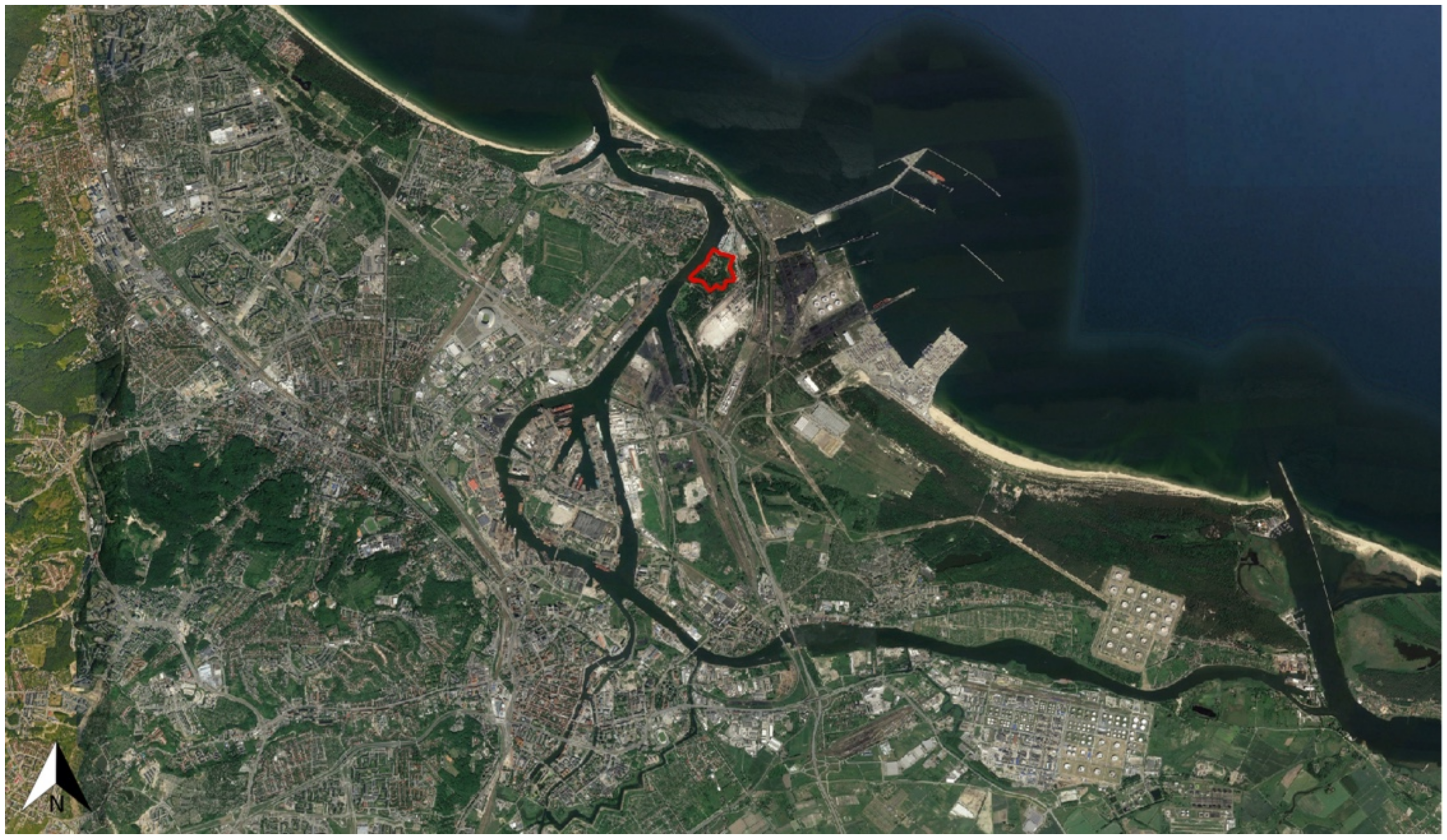
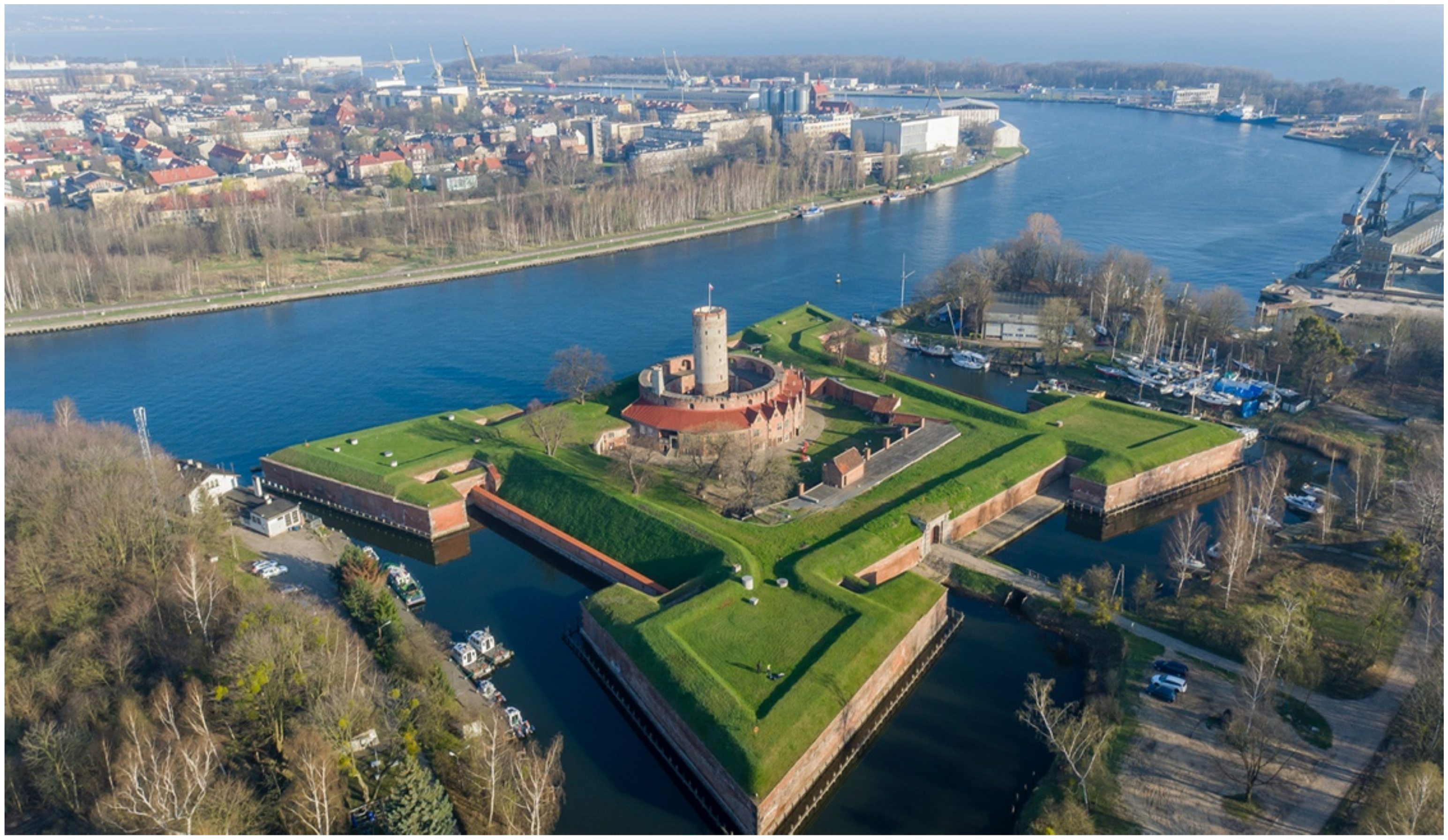
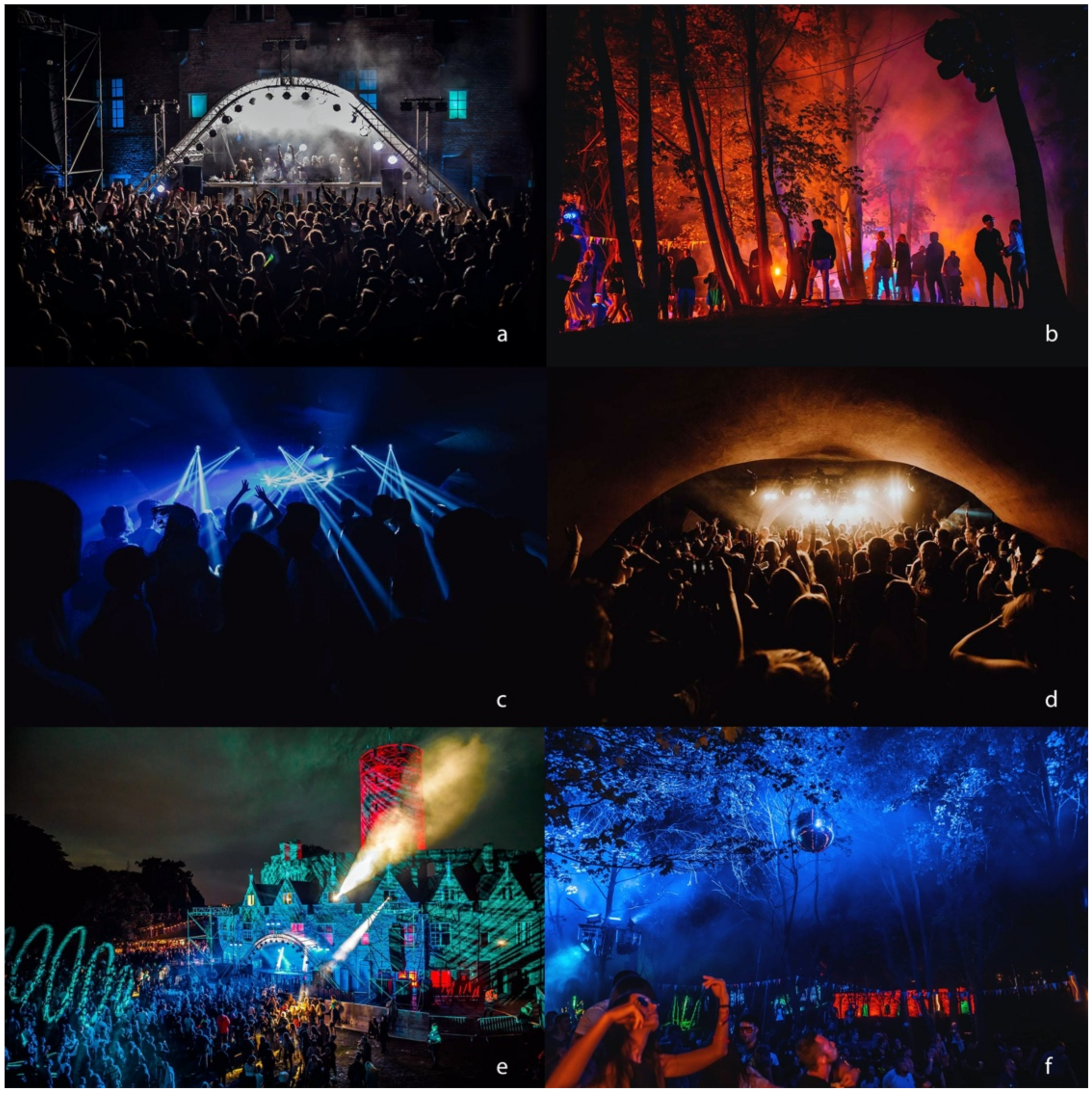
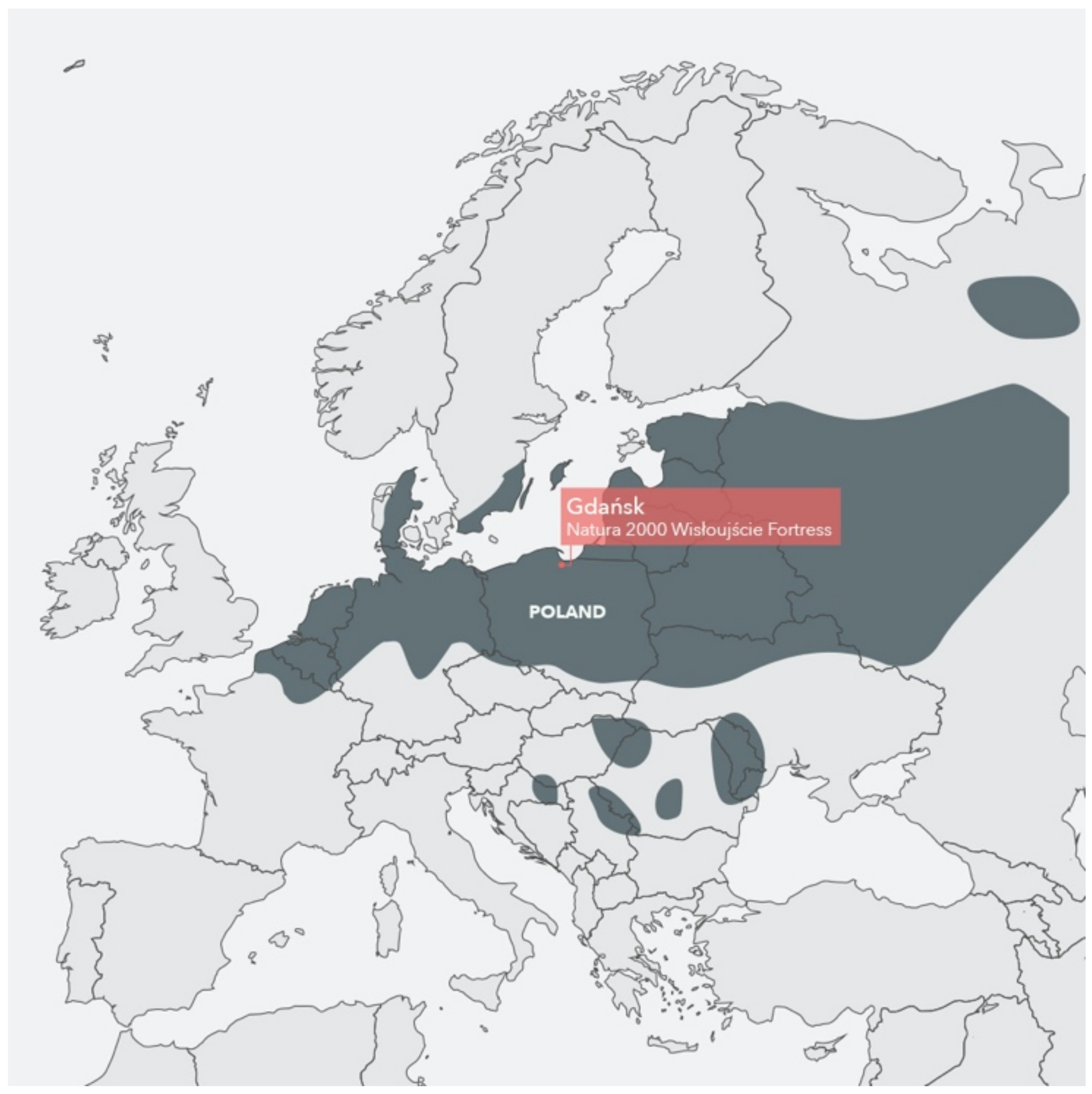
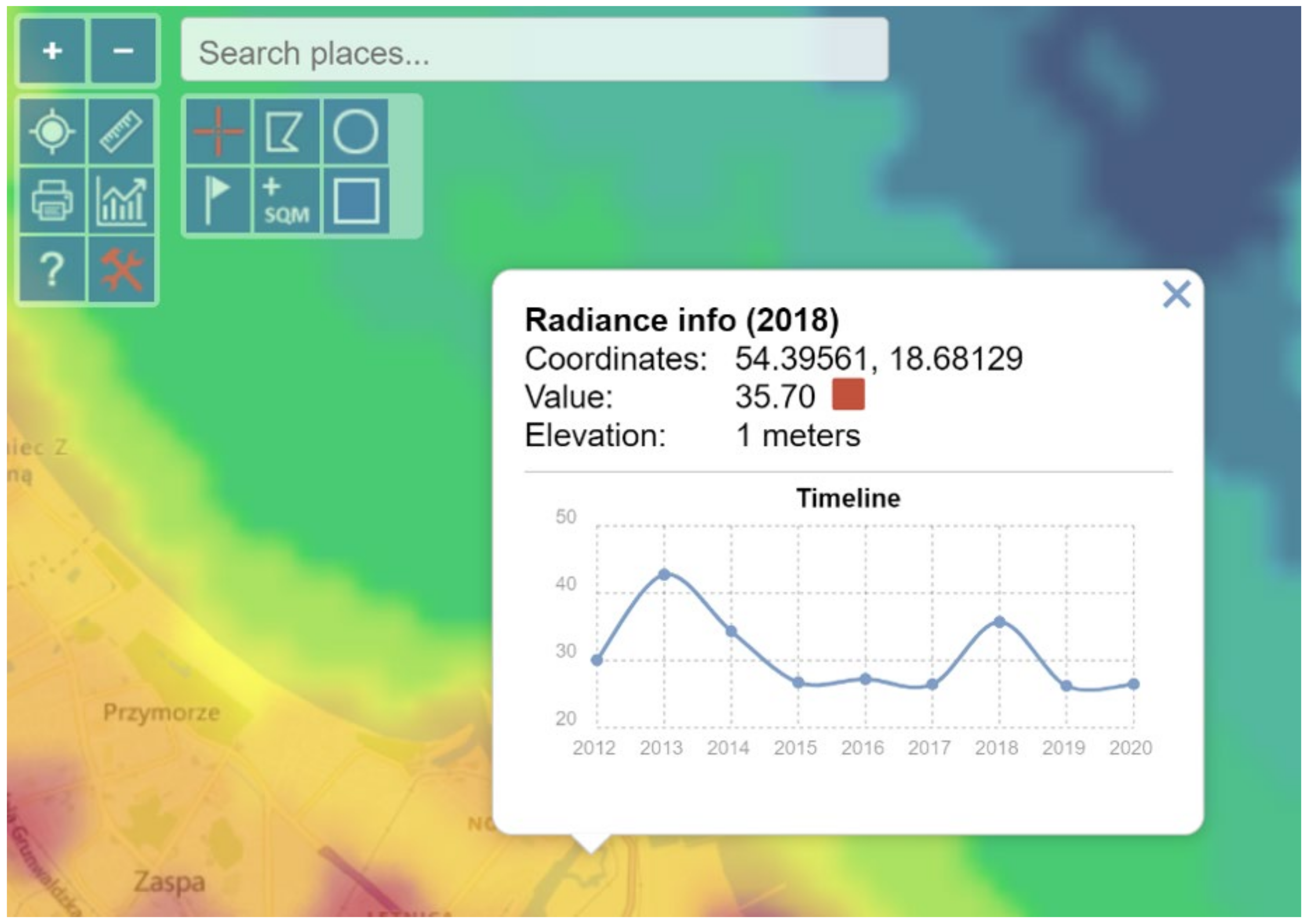



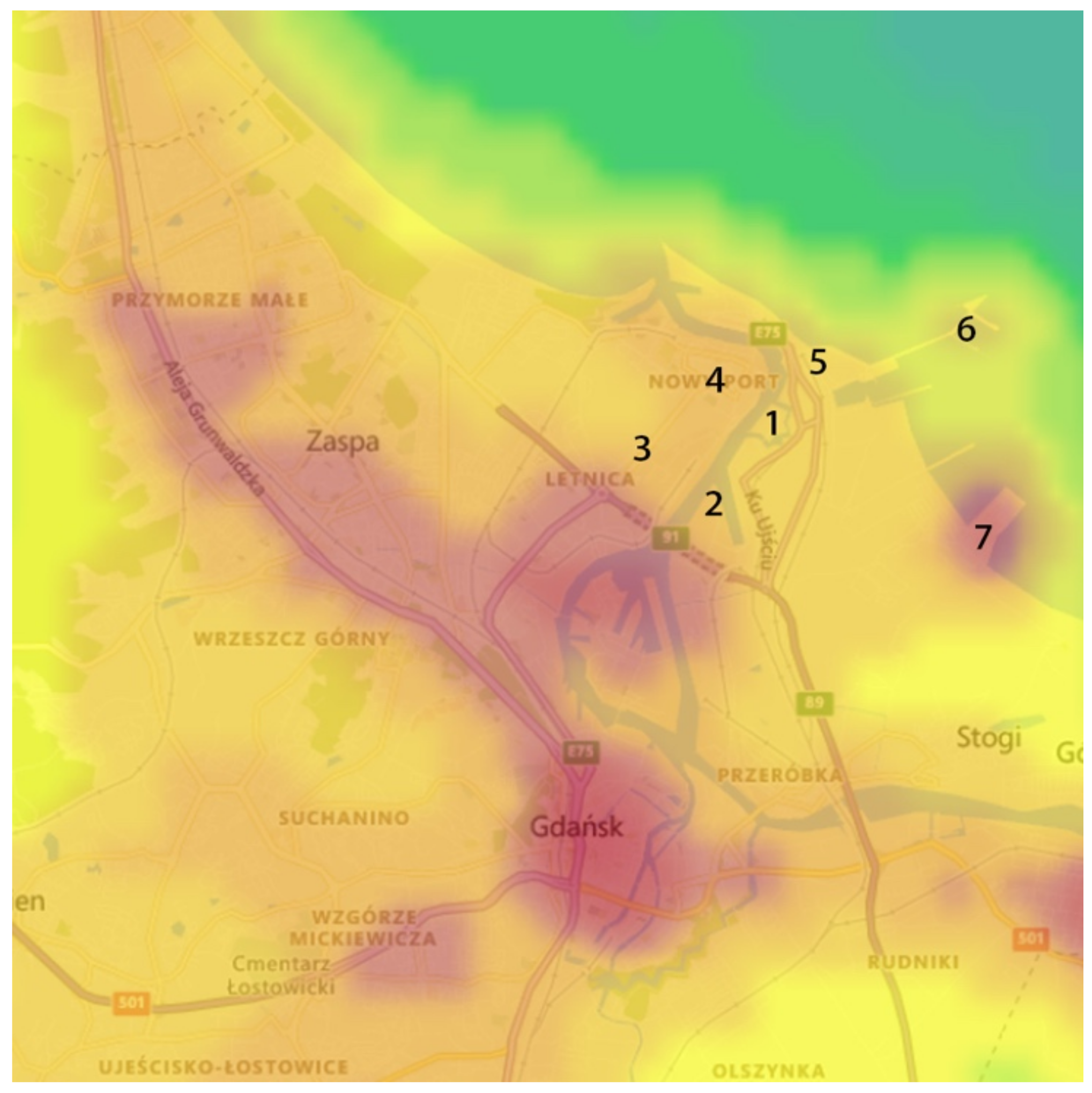

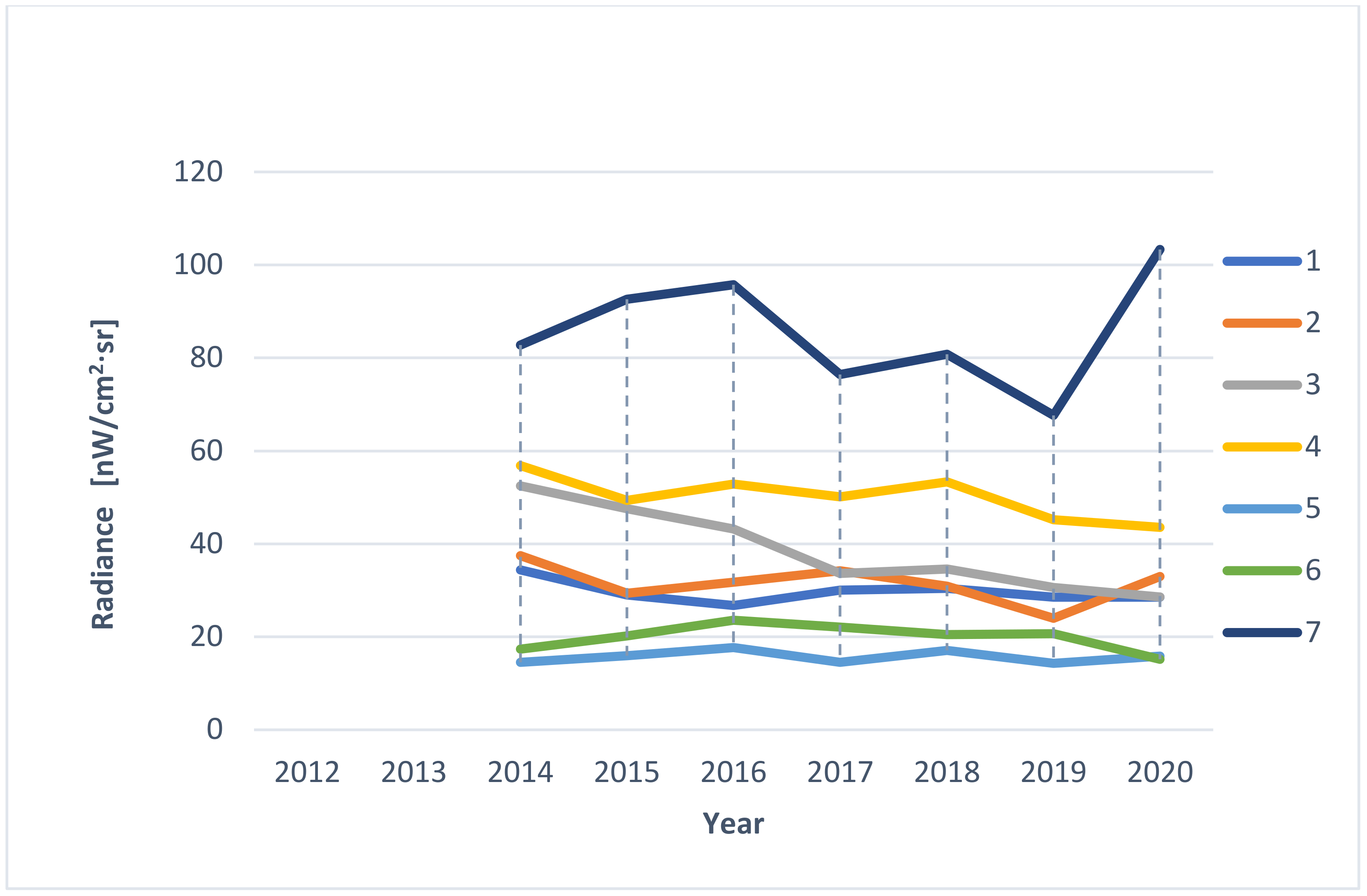





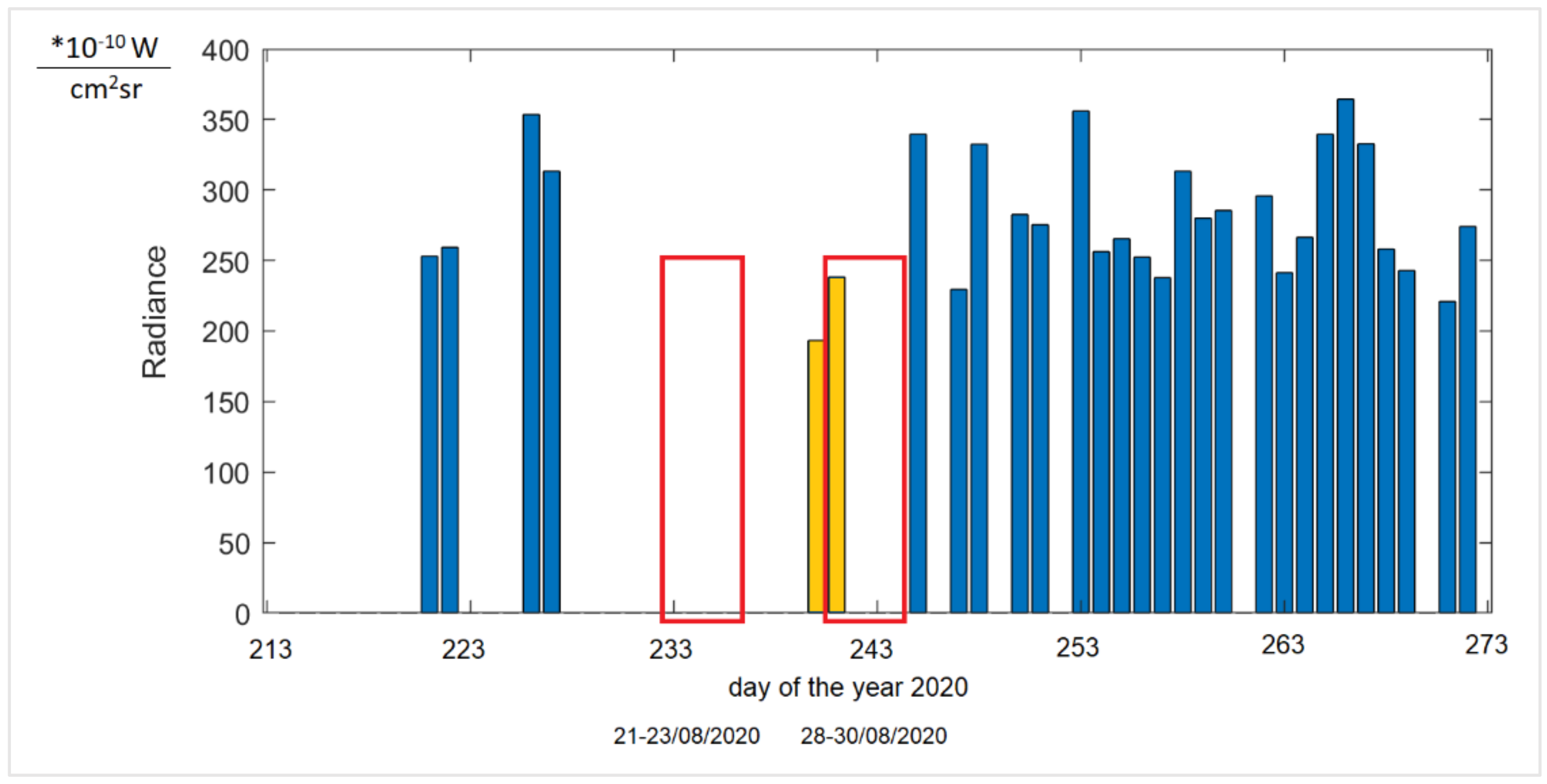
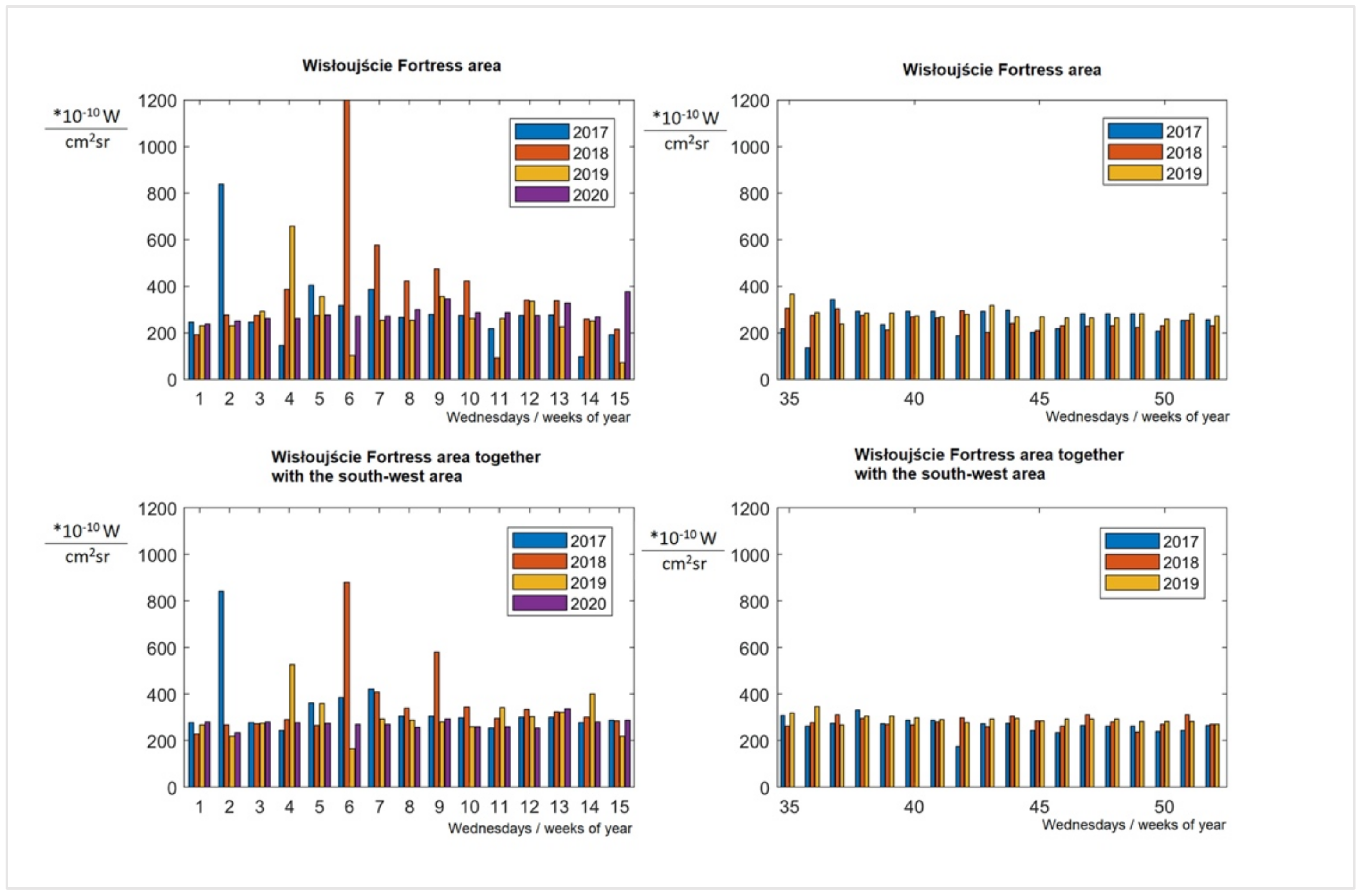

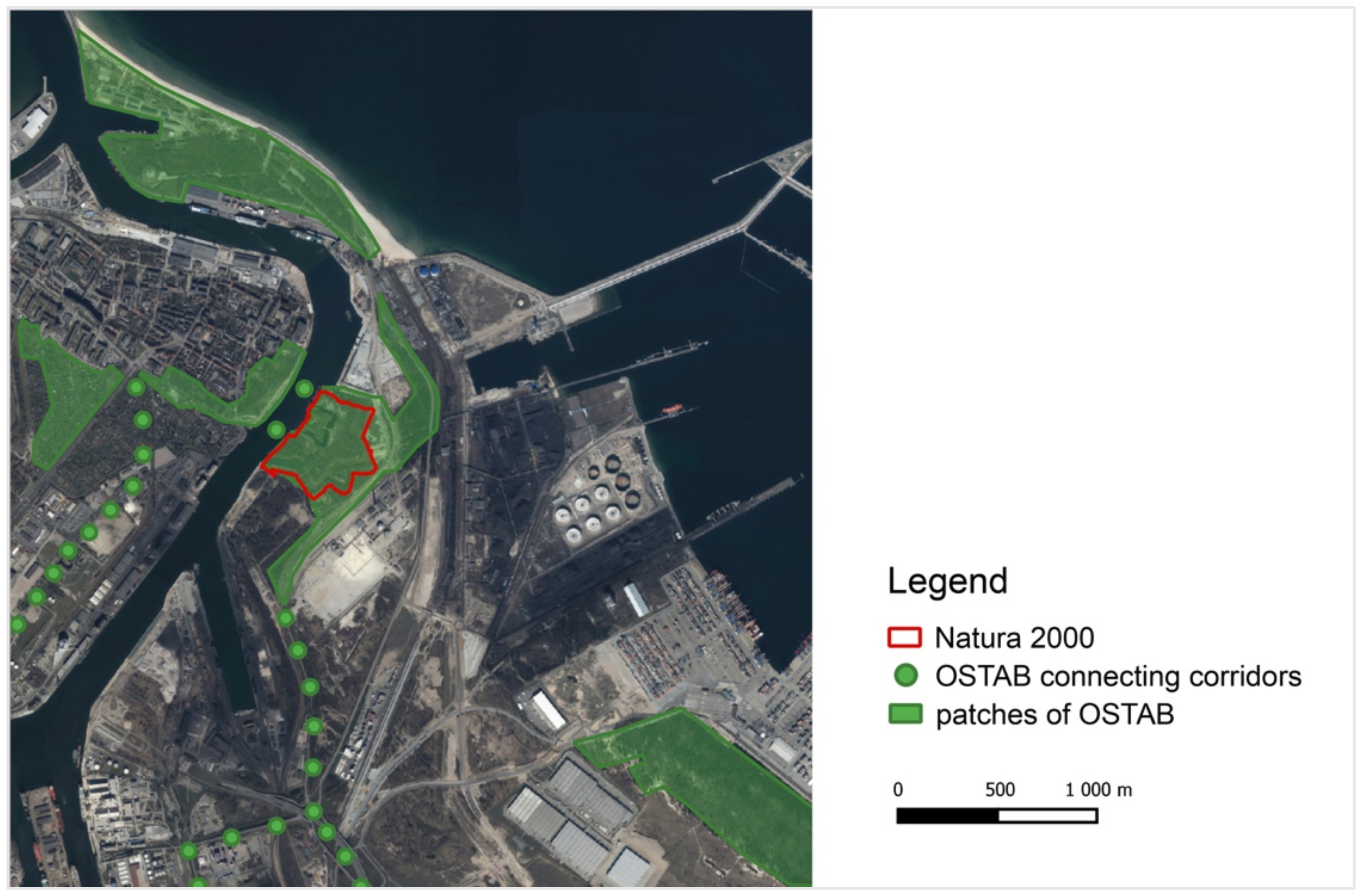
| Point Number | Geographical Coordinates | |
|---|---|---|
| 1 | 54.39530, 18.68005 | Wisłoujście Fortress (pl. Twierdza Wisłoujście) |
| 2 | 54.38898, 18.66985 | Przeróbka district, near the mining pool (pl. Dzielnica Przeróbka okolice basenu górniczego) |
| 3 | 54.39209, 18.65740 | Outskirts of the Letnica district (pl. Obrzeża dzielnicy Letnica) |
| 4 | 54.40069, 18.67095 | The Nowy Port district (pl. Dzielnica Nowy Port) |
| 5 | 54.40234, 18.68596 | Outskirts of the Gdańsk Shipyard (pl. Obrzeża Portu Północnego) |
| 6 | 54.40530, 18.71971 | The Northern Port area (pl. Port Północny) |
| 7 | 54.38540, 18.71886 | The DCT Gdańsk S.A. container terminal (pl. DCT terminal Kontenerowy) |
| Level 2 | Area (m2) | Level 3 | Area (m2) | ||
|---|---|---|---|---|---|
| Code | The Name of the Object | Code | The Name of the Object | ||
| PTWP | surface water | 43,811.78 | PTWP02 | flowing water | 43,811.78 |
| PTZB | building | 15,978.81 | PTZB03 | industrial and storage buildings | 4121.74 |
| PTZB05 | remaining buildings | 11,857.07 | |||
| PTLZ | forest and wooded area | 75,875.17 | PTLZ01 | forest | 75,875.17 |
| PTTR | grassy vegetation and agricultural cultivation | 26,064.04 | PTTR01 | grassy vegetation | 26,064.04 |
| Sum | 161,729.80 | ||||
| Year | Number of Pond Bats | Daytime Event 1 | Nighttime Event 2 |
|---|---|---|---|
| 2011 | 5 | + | |
| 2012 | 7 | + | |
| 2013 | 4 | + | |
| 2014 | 9 | + | |
| 2015 | 8 | + | |
| 2016 | 0 | + | |
| 2017 | 0 | + | |
| 2018 | 0 | + | |
| 2019 | 0 | + | |
| 2020 | 1 | + |
| Point | Year | Value Differences in Point Measurements | |||||||||
|---|---|---|---|---|---|---|---|---|---|---|---|
| 2014 | 2015 | 2016 | 2017 | 2018 | 2019 | 2020 | Average | Minimum | Maximum | ||
| 1 | 8.95 | 2.93 | 0.96 | 2.01 | 11.72 | 1.51 | 2.58 | 4.38 | 0.96 | 11.72 | |
| 2 | 12.93 | 0.52 | 0.46 | 4.52 | 2.67 | 1.21 | 0.49 | 3.26 | 0.46 | 12.93 | |
| 3 | 16.61 | 18.33 | 2.16 | 2.52 | 7.90 | 2.17 | 0.25 | 7.13 | 0.25 | 18.33 | |
| 4 | 11.06 | 5.94 | 3.50 | 1.94 | 4.40 | 3.90 | 0.75 | 4.50 | 0.75 | 11.06 | |
| 5 | 2.33 | 0.53 | 3.71 | 1.03 | 1.52 | 0.49 | 1.48 | 1.58 | 0.49 | 3.71 | |
| 6 | 2.64 | 5.40 | 3.10 | 0.28 | 1.30 | 2.24 | 4.32 | 2.75 | 0.28 | 5.40 | |
| 7 | 5.63 | 5.10 | 0.88 | 2.49 | 8.06 | 1.91 | 17.32 | 5.91 | 0.88 | 17.32 | |
| Value differences in annual analyses | Average | 8.59 | 5.54 | 2.11 | 2.11 | 5.37 | 1.92 | 3.88 | 4.22 | - | - |
| Minimum | 2.33 | 0.52 | 0.46 | 0.28 | 1.30 | 0.49 | 0.25 | - | 0.25 | - | |
| Maximum | 16.61 | 18.33 | 3.71 | 4.52 | 11.72 | 3.90 | 17.32 | - | - | 18.33 | |
| The Date of the Event dd/mm/yyyy | Nighttime Events | Data | |||
|---|---|---|---|---|---|
| Date | Description | Characteristic | Possibility of Use | ||
| 13/08/2016 | Naval Battle. Secrets of the Wisłoujście Fortress | 11/08/2016 | VNP46A2.A2016224 | No data coverage | - |
| 12/08/2016 | VNP46A2.A2016225 | No data coverage | - | ||
| 13/08/2016 | VNP46A2.A2016226 | Very low quality | No | ||
| 25–26/08/2018 | Festival Wisłoujście | 24/08/2018 | VNP46A2.A2018236 | Highly cloudy | No |
| 25/08/2018 | VNP46A2.A2018237 | Highly cloudy | No | ||
| 26/08/2018 | VNP46A2.A2018238 | No data coverage | - | ||
| 27/08/2018 | VNP46A2.A2018239 | High quality | Yes | ||
| 09–11/08/2019 | Festival Wisłoujście | 08/08/2019 | VNP46A2.A2019220 | No data coverage | No |
| 09/08/2019 | VNP46A2.A2019221 | No data coverage | No | ||
| 10/08/2019 | VNP46A2.A2019222 | No data coverage | - | ||
| 11/08/2019 | VNP46A2.A2019223 | No data coverage | - | ||
| 12/08/2019 | VNP46A2.A2019224 | Very low quality | No | ||
| 21–23/08/2020 | Festival Wisłoujście | 21/08/2020 | VNP46A2.A2020234 | No data coverage | No |
| 22/08/2020 | VNP46A2.A2020235 | Very low quality | No | ||
| 23/08/2020 | VNP46A2.A2020236 | Very low quality | No | ||
| 28–30/08/2020 | Festival Wisłoujście | 27/08/2020 | VNP46A2.A2020240 | High quality | Yes |
| 28/08/2020 | VNP46A2.A2020241 | High quality | Yes * | ||
| 29/08/2020 | VNP46A2.A2020242 | Very low quality | No | ||
| 30/08/2020 | VNP46A2.A2020243 | Very low quality | No | ||
| 31/08/2020 | VNP46A2.A2020244 | Very low quality | No | ||
Publisher’s Note: MDPI stays neutral with regard to jurisdictional claims in published maps and institutional affiliations. |
© 2021 by the authors. Licensee MDPI, Basel, Switzerland. This article is an open access article distributed under the terms and conditions of the Creative Commons Attribution (CC BY) license (https://creativecommons.org/licenses/by/4.0/).
Share and Cite
Zielinska-Dabkowska, K.M.; Szlachetko, K.; Bobkowska, K. An Impact Analysis of Artificial Light at Night (ALAN) on Bats. A Case Study of the Historic Monument and Natura 2000 Wisłoujście Fortress in Gdansk, Poland. Int. J. Environ. Res. Public Health 2021, 18, 11327. https://doi.org/10.3390/ijerph182111327
Zielinska-Dabkowska KM, Szlachetko K, Bobkowska K. An Impact Analysis of Artificial Light at Night (ALAN) on Bats. A Case Study of the Historic Monument and Natura 2000 Wisłoujście Fortress in Gdansk, Poland. International Journal of Environmental Research and Public Health. 2021; 18(21):11327. https://doi.org/10.3390/ijerph182111327
Chicago/Turabian StyleZielinska-Dabkowska, Karolina M., Katarzyna Szlachetko, and Katarzyna Bobkowska. 2021. "An Impact Analysis of Artificial Light at Night (ALAN) on Bats. A Case Study of the Historic Monument and Natura 2000 Wisłoujście Fortress in Gdansk, Poland" International Journal of Environmental Research and Public Health 18, no. 21: 11327. https://doi.org/10.3390/ijerph182111327
APA StyleZielinska-Dabkowska, K. M., Szlachetko, K., & Bobkowska, K. (2021). An Impact Analysis of Artificial Light at Night (ALAN) on Bats. A Case Study of the Historic Monument and Natura 2000 Wisłoujście Fortress in Gdansk, Poland. International Journal of Environmental Research and Public Health, 18(21), 11327. https://doi.org/10.3390/ijerph182111327








